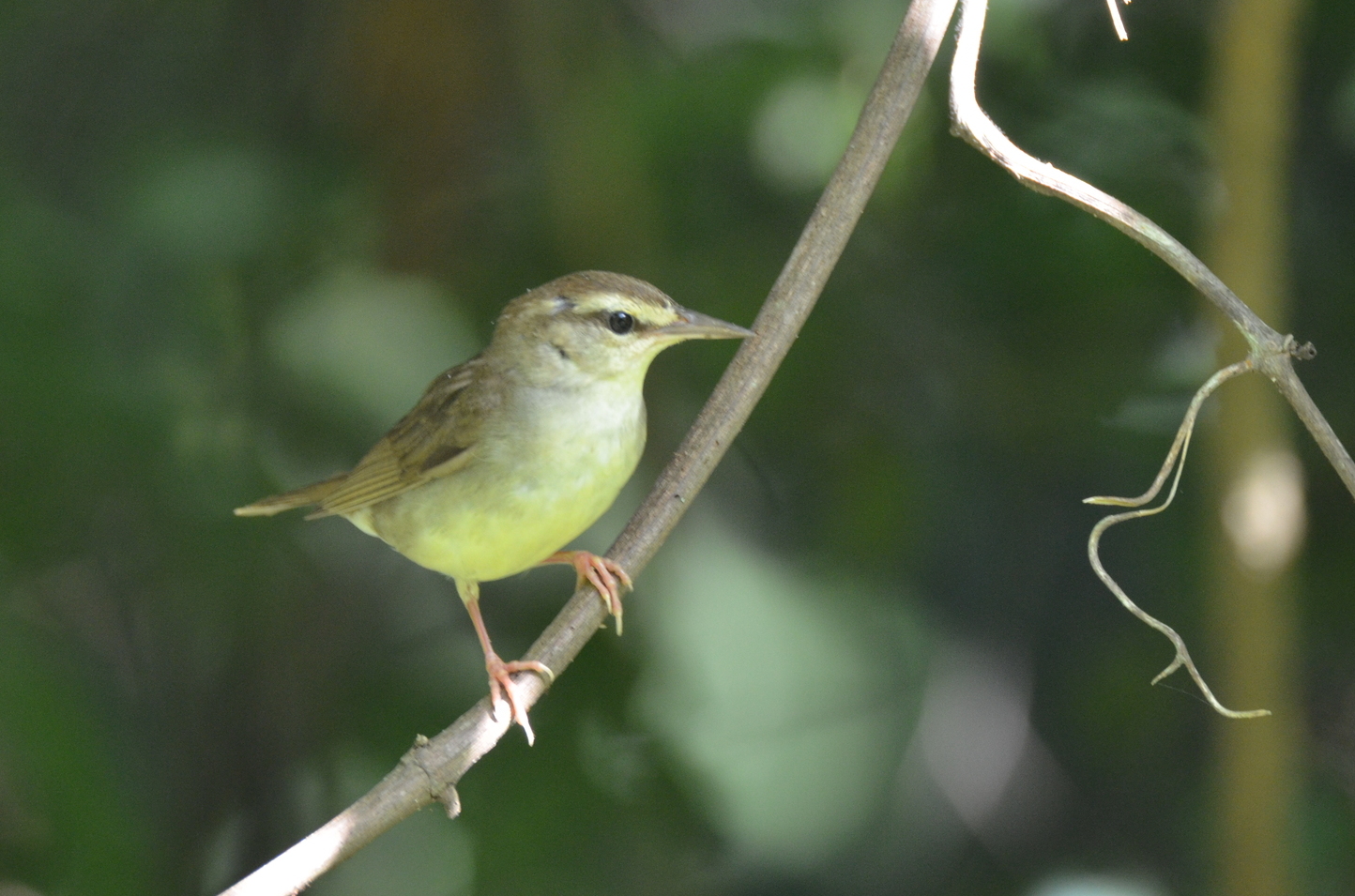Discover the incredible variety of warbler species that can be regularly found in Louisiana with the help of this guide. Complete with captivating photographs, detailed descriptions, enchanting audio recordings of their melodious songs, and fascinating trivia, this guide will assist you in identifying these beautiful migratory songbirds.
Warblers, these small avian travelers, embark on remarkable journeys spanning vast distances, from South America to breeding grounds as far as Canada. With their vibrant plumage, these active and vibrant creatures grace us with a fleeting glimpse of yellow and green as they transition from their breeding to wintering grounds, serenading us with a delightful repertoire of melodies.
Renowned as wood-warblers, these North American treasures predominantly inhabit woodland and forested areas. It’s worth noting that you might experience the peculiar “warbler neck,” a discomforting stiffness and tingling sensation in your neck resulting from the ardent pursuit of spotting these elusive birds high up in the trees through your trusty binoculars.
While warblers primarily sustain themselves on insects, they occasionally visit backyard feeders in search of seeds or delectable mealworms. Discover other bird species that frequently grace Louisiana with their presence and avail a complimentary identification chart.
This comprehensive guide serves as your compass in identifying the regularly occurring warbler species in Louisiana, providing accurate information sourced from avibase and data collected by avid birdwatchers on ebird regarding the optimal times to spot these avian wonders.
Warblers that can be found in Louisiana throughout the year include the Pine Warbler, Common Yellowthroat, and Black-and-white Warbler.
During the summer months, you can also spot the Northern Parula, Prothonotary Warbler, Hooded Warbler, Yellow-breasted Chat, Yellow-throated Warbler, Kentucky Warbler, Worm-eating Warbler, Prairie Warbler, Swainson’s Warbler, and Louisiana Waterthrush.
In the winter, keep an eye out for the Yellow-rumped Warbler, Orange-crowned Warbler, Palm Warbler, and Wilson’s Warbler.
During migration periods, numerous warbler species can be observed, including the Yellow Warbler, American Redstart, Tennessee Warbler, Magnolia Warbler, Black-throated Green Warbler, Northern Waterthrush, Ovenbird, Chestnut-sided Warbler, Blue-winged Warbler, Blackburnian Warbler, Bay-breasted Warbler, Nashville Warbler, Blackpoll Warbler, Canada Warbler, Cerulean Warbler, Golden-winged Warbler, Cape May Warbler, Mourning Warbler, and Black-throated Blue Warbler.
Curious about the songs of these delightful creatures? Often, you will hear the harmonious melodies of warblers before spotting them. Familiarizing yourself with their distinct songs will enhance your ability to identify these remarkable birds. Luckily, some warblers possess more easily recognizable songs than others.
Warbler songs can be characterized as either buzzy, clear, or trilling, featuring captivating pitch variations and an array of captivating sounds. Buzzy notes resemble the hum of insects, clear notes imitate melodious whistles, while trills are swift and intricate, rendering individual notes indistinguishable.
To assist you further, this guide offers an invaluable resource—a compilation of 13 warbler songs that are simple to recognize.
Let’s delve into the enchanting world of warbler songs:
- The Black-throated Blue Warbler’s song exhibits a rising, buzzy quality.
- Prairie Warblers produce songs with a buzzing quality that rises.
- Black-throated Green Warblers emit a buzzy tune, interspersed with a couple of clear notes in the middle.
- Blackpoll Warblers’ songs are clear and steady, reminiscent of the buzz emitted by an insect.
- Prairie Warblers’ songs are buzzy and gradually increase in pitch.
- Palm Warblers produce a delightfully buzzy song.
Among the warblers with songs featuring clear notes are:
- The Common Yellowthroat’s song comprises a series of rising and falling notes, repeatedly sung.
- Ovenbirds sing a series of notes that rise and fall.
- Hooded Warblers also showcase clear notes in their songs.
- The Chestnut-sided Warbler’s song consists of a series of clear, descending notes that accelerate towards the end.
- Yellow-rumped Warblers produce a series of clear notes that gradually fade away.
- Yellow Warblers’ songs accelerate in tempo.
- Northern Parulas deliver a trilling song that ascends, culminating in a distinctive concluding note, reminiscent of a period marking its final flourish.
- Wilson’s Warblers sing a series of clear, descending notes that gradually hasten.
Prepare to be astounded as we introduce you to the captivating realm of 36 warbler species that grace Louisiana:
1. Yellow-rumped Warbler
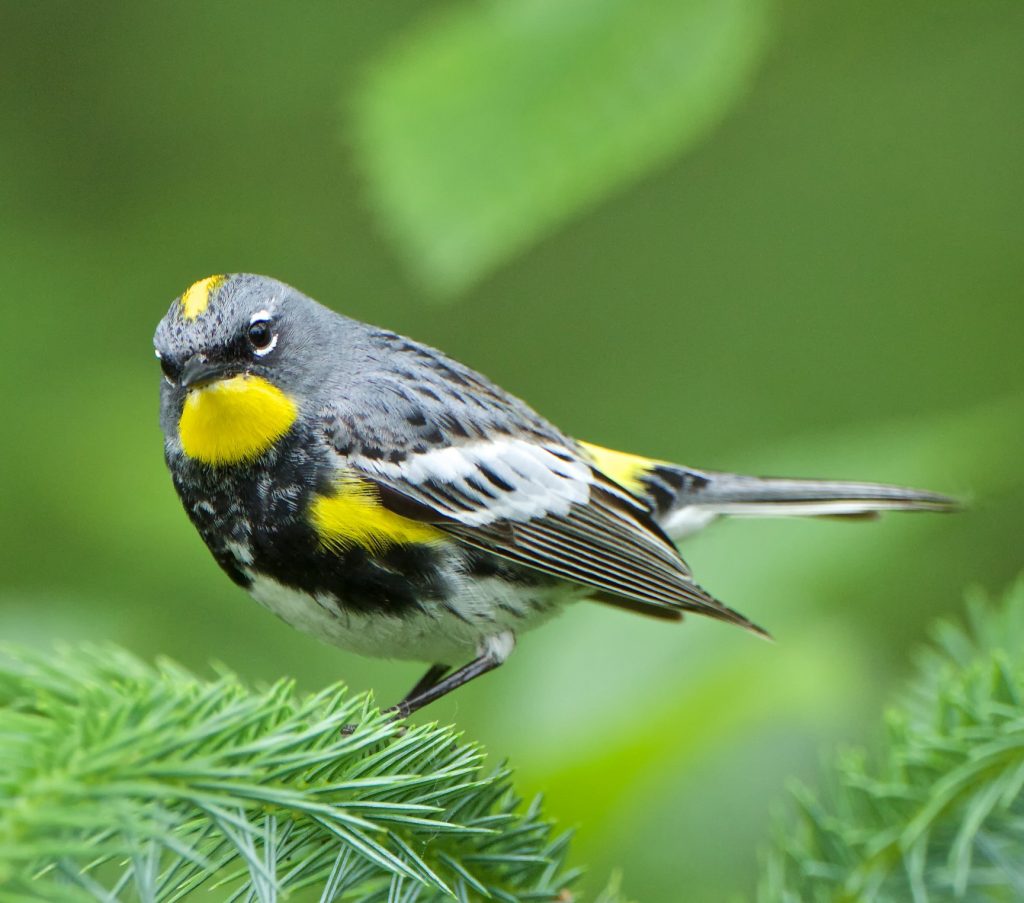
Yellow-rumped Warblers delight Louisiana’s winter season, arriving as early as September and remaining until May. However, the prime months for sighting them are October through April. Birdwatchers have recorded their presence in 51% of winter checklists submitted for the state.
These dainty birds exhibit gray plumage adorned with flashes of yellow on their faces, sides, and rumps, complemented by white wings. Females may exhibit a subtle brown hue, while winter birds don a lighter brown coloration, with their rumps and sides transitioning to a vibrant yellow before reverting to gray in spring.
Two subspecies exist: the Myrtle Warbler from the eastern United States and boreal forests of Canada, which lacks the yellow throat, and the Audubon’s Warbler from the west, which boasts additional white wing markings.
Scientific Name: Setophaga coronata
Length: 4.7-5.5 in (12-14 cm)
Weight: 0.4-0.5 oz (12-13 g)
Wingspan: 7.5-9.1 in (19-23 cm)
Yellow-rumped Warblers primarily breed in Canada, the Rockies, and the Appalachian mountains. During migration, they traverse the Midwest before settling in the southern and southwestern states of the US, extending to the Pacific Coast, Mexico, and Central America.
These warblers favor coniferous forests during the breeding season and open areas with fruiting shrubs during winter. Their diet predominantly consists of insects during the summer and migration, transitioning to fruit consumption, including bayberries and wax myrtles, during the winter months.
Take a moment to acquaint yourself with the delightful song of the Yellow-rumped Warbler. Listen to the recording by Christopher McPherson, accessible at www.xeno-canto.org/602699.
Female Yellow-rumped Warblers construct nests in conifer trees, fashioning them from twigs, pine needles, grass, and lining them with soft grass, moss, and hair. These diligent mothers lay up to six eggs, which incubate for approximately two weeks before the fledglings depart the nest after an additional two weeks.
To attract these charming visitors to your backyard, entice them with sunflower seeds, suet, raisins, and peanut butter.
Fun Fact: During winter, Yellow-rumped Warblers form massive flocks, numbering in the thousands. They exhibit territorial behavior, displaying aggression towards intruders of other species venturing too close to their flock.
2. Pine Warbler
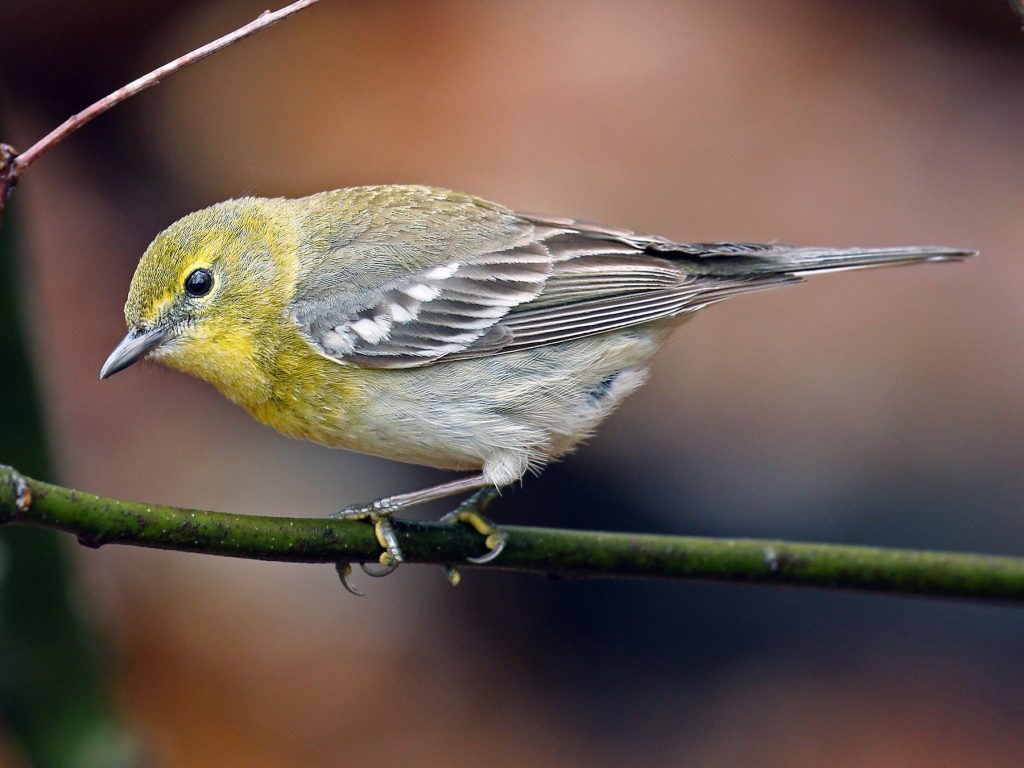
Pine Warblers can be spotted throughout the year in Louisiana, with a higher prevalence in the state’s northern regions during the breeding season. They feature in 10% of summer checklists and 20% of winter checklists submitted by birdwatchers.
With their plump bodies, Pine Warblers showcase a striking yellow hue, complemented by olive backs, white lower bellies, and gray wingbars. Females may exhibit a slightly browner coloration, with increased white on their bellies.
Scientific Name: Setophaga pinus
Length: 5.1-5.5 in (13-14 cm)
Weight: 0.3-0.5 oz (9-15 g)
Wingspan: 7.5-9.1 in (19-23 cm)
Pine Warblers breed in northeastern US states before embarking on their journey to southeastern US states. Some individuals remain in the southeastern region throughout the year.
These charming birds can be found primarily in pine forests, as their name suggests, often perched high up in the trees. Their diet predominantly consists of caterpillars, beetles, spiders, and other insects and larvae. During colder weather, they supplement their diet with fruit and seeds.
Immerse yourself in the melodious song of the Pine Warbler. Listen to the recording by Christopher McPherson, accessible at www.xeno-canto.org/602052.
Pine Warblers construct nests in—you guessed it—pine trees! These nests are skillfully fashioned from twigs, bark, pine needles, and grass, bound together with spider silk. Lined with feathers and animal hair, the nests house up to five eggs, which hatch after a two-week incubation period. The fledglings take flight approximately ten days later.
To invite Pine Warblers into your yard, consider using tube feeders and platform feeders stocked with millet, cracked corn, sunflower seeds, peanut hearts, and suet. Additionally, cultivate native fruit-bearing plants and vines, such as bayberry, grape, sumac, and Virginia creeper.
Fun Fact: Pine Warblers are among the few warbler species that primarily consume seeds, making them more likely visitors to backyard feeders.
3. Orange-crowned Warbler

Orange-crowned Warblers are winter visitors to Louisiana, observed between mid-September and April. These delightful birds feature in 26% of checklists during this period.
Sporting yellow-olive plumage, Orange-crowned Warblers lack the vibrant hues typically associated with other warbler species. However, their yellow coloring intensifies along the Pacific Coast. Males and females share similar appearances, while juveniles exhibit a grayer plumage.
Scientific Name: Leiothlypis celata
Length: 4.3-5.5 in (11-14 cm)
Weight: 0.3-0.4 oz (7-11 g)
Wingspan: 7.5 in (19 cm)
Orange-crowned Warblers breed in Canada and western US states before embarking on their migratory journeys to the Pacific, East and Gulf Coasts, and Mexico. They are visible during migration in most US states, excluding the northeastern region.
These warblers can be found in shrubs and low vegetation, though they tend to breed in open woodland areas. Their diet primarily consists of spiders and insects, including caterpillars and flies. They also partake in fruit, berries, and seeds, making regular appearances at backyard feeders.
Experience the delightful song of the Orange-crowned Warbler. Listen to the recording by Paul Marvin, accessible at www.xeno-canto.org/671865.
Orange-crowned Warbler nests are located near or on the ground, constructed from dead leaves, twigs, and stems, lined with soft grass and animal hair. They lay up to six eggs.
To attract these charming birds to your yard, offer suet, peanut butter, or hummingbird feeders filled with sugar water nectar.
Fun Fact: Orange-crowned Warblers have been observed drinking from the sapwells created by sapsuckers and woodpeckers.
4. Common Yellowthroat
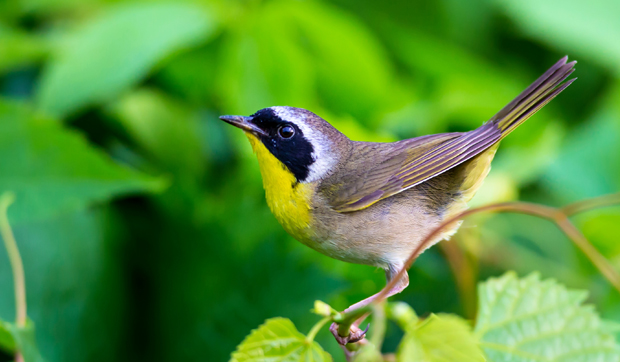
Common Yellowthroats can be found year-round in southern Louisiana, though they are more prevalent during the breeding season in the northern regions. They feature in 15% of summer checklists and 8% of winter checklists.
These small songbirds boast a brownish back and vibrant yellow plumage underneath, complete with long tails. Males possess a distinctive black mask across their faces. The intensity of the yellow coloring may vary geographically, with some individuals showcasing a more olive hue on their undersides.
Scientific Name: Geothlypis trichas
Length: 4.3-5.1 in (11-13 cm)
Weight: 0.3-0.3 oz (9-10 g)
Wingspan: 5.9-7.5 in (15-19 cm)
Common Yellowthroats breed across most of North America, excluding Alaska and northern Canada. Some individuals remain along the Gulf Coast and Pacific Southwest throughout the year, while others embark on migratory journeys southward for winter.
These charming birds are often found in marshy or wetland areas, as well as brushy fields, taking up residence amidst dense and tangled vegetation.
Indulge in the melodious song of the Common Yellowthroat. Listen to the recording by Paul Marvin, accessible at www.xeno-canto.org/629250.
Female Common Yellowthroats construct nests near the ground in marshy areas, supported by reeds. These nests are skillfully fashioned from grass, sedges, and leaves, forming a cup-shaped structure. They lay up to six eggs, which incubate for approximately twelve days, followed by an additional twelve days for the young to fledge.
To attract Common Yellowthroats to larger backyards, provide dense vegetation and native plants that attract insects.
Fun Fact: Common Yellowthroats identify courting males through the presence of black masks, exhibiting aggressive behavior towards decoy birds donning masks. However, they do not display aggression when encountering birds without masks.
5. Northern Parula

Northern Parulas grace Louisiana during the breeding season, featuring in 10% of summer checklists. They are predominantly observed from March until mid-November.
These captivating warblers showcase a delightful contrast of blue-gray and yellow tones. Their backs sport a bluish-gray hue, accentuated by a yellow patch, with two white wingbars adding to their charm.
Males possess a chestnut band that separates the yellow throat and chest—a distinctive feature shared by both males and females. Females exhibit a paler plumage compared to their male counterparts, lacking the chestnut band. Juveniles showcase a paler appearance overall.
Scientific Name: Setophaga americana
Length: 4.3-4.7 in (11-12 cm)
Weight: 0.2-0.4 oz (5-11 g)
Wingspan: 6.3-7.1 in (16-18 cm)
Northern Parulas breed in eastern US states and southeastern Canada before embarking on migratory journeys to Central America and the Caribbean for winter. Some individuals opt to spend their winters in southern Florida.
These delightful birds are often spotted foraging on insects in deciduous forests.
Immerse yourself in the trilling song of the Northern Parula. Listen to the recording by Christopher McPherson, accessible at www.xeno-canto.org/599828.
Nests of Northern Parulas are intricately woven in long clumps of lichen and moss, draping from tree branches. Keep an eye out for large clumps of hanging moss, as they often serve as indicators of nesting sites during the summer season.
To attract Northern Parulas to your backyard, cultivate native trees and shrubs—especially those bearing berries—and create brush piles to provide insect-friendly habitats.
Fun Fact: Northern Parula females shoulder the responsibility of rearing their young, incubating the eggs and feeding the fledglings. Males contribute by singing and removing fecal sacs from the nest!
6. Prothonotary Warbler
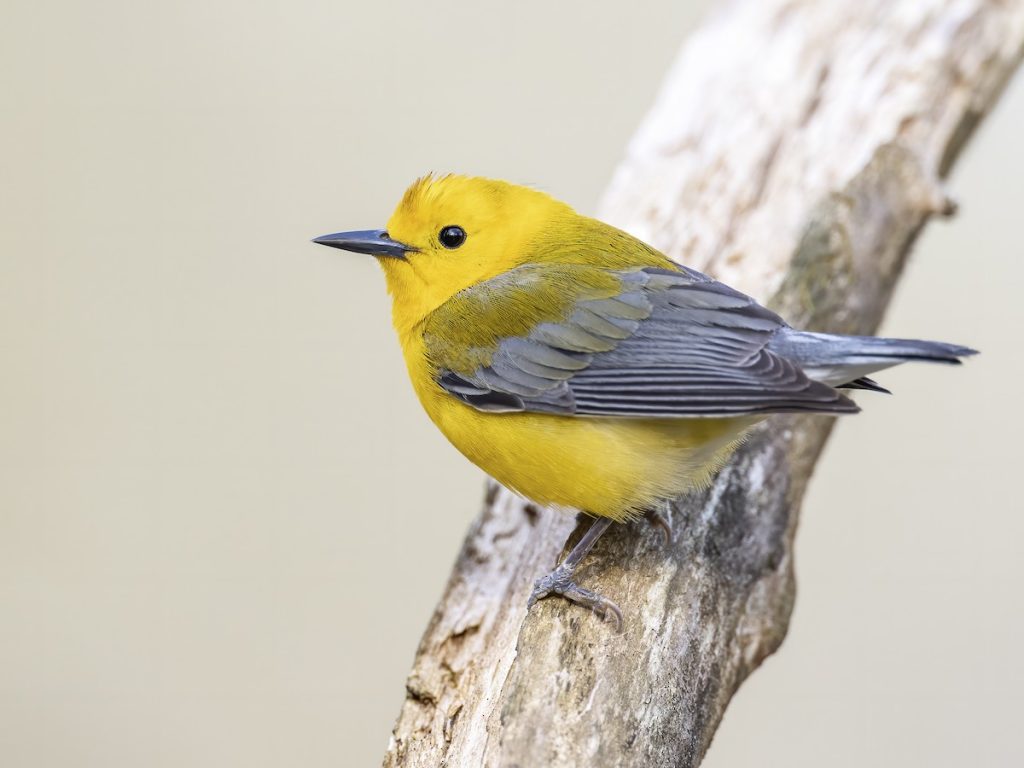
Prothonotary Warblers grace Louisiana during the breeding season, from March to October, featuring in 14% of summer checklists.
These eye-catching birds sport a vibrant yellow plumage with blue-gray wings and tails. They are relatively larger compared to other warbler species and boast thick black beaks. Their white under-tail is visible when they flick their tails.
Scientific Name: Protonotaria citrea
Length: 5.1 in (13 cm)
Weight: 0.44 oz (12.5 g)
Wingspan: 8.75 in (22 cm)
Prothonotary Warblers breed in eastern US states, and during winter, they migrate southward to Mexico and northern South America.
These delightful warblers can be found near streams and in wet woodlands, where they forage for spiders, insects, and snails. During winter, they also consume fruit and seeds.
Indulge in the charming song of the Prothonotary Warbler. Listen to the recording by Matt Wistrand, accessible at www.xeno-canto.org/565451.
Prothonotary Warblers utilize abandoned woodpecker nest holes in trees, typically near water bodies, for nesting. The male starts by placing moss inside the hole, while the female builds a cup-shaped nest using grass, leaves, and other plant materials.
They lay up to seven eggs, which incubate for about two weeks, followed by an additional ten days for the fledglings to leave the nest.
To attract Prothonotary Warblers to your yard, consider installing a nest box if you live near wetland areas.
Fun Fact: Prothonotary Warblers derive their name from the bright yellow robes, called “prothonotary,” worn by officials in the Roman Catholic Church.
7. Hooded Warbler
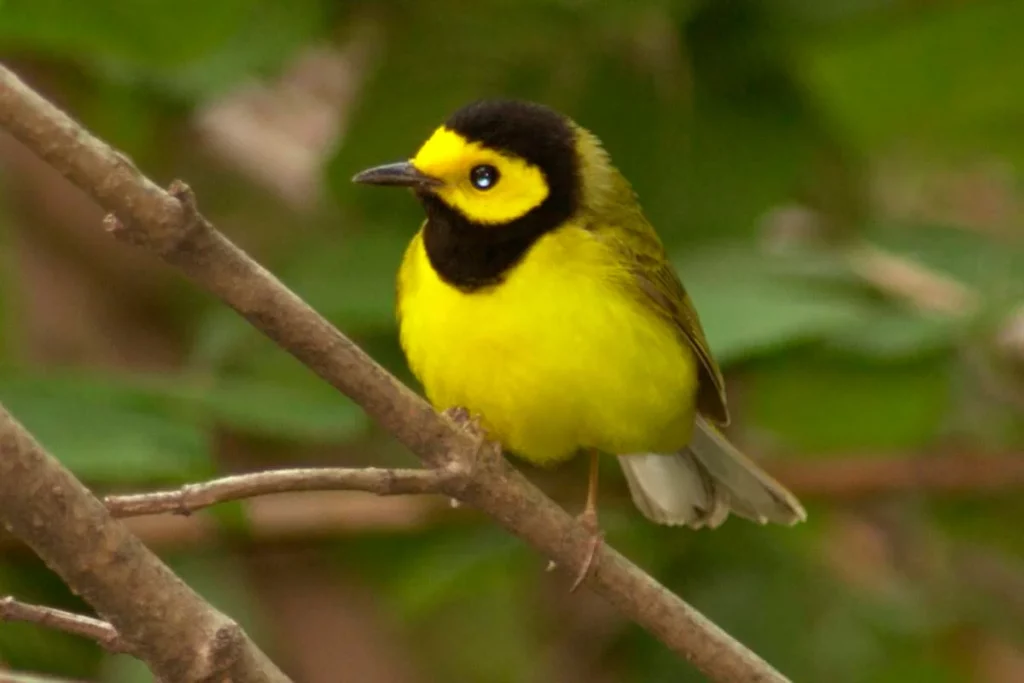
Hooded Warblers breed in Louisiana, with sightings from March to November, featuring in 9% of summer checklists.
Male Hooded Warblers exhibit a striking appearance, with a bright yellow face, a distinct black hood and throat, and yellow underparts. They sport olive-green plumage on their upper body. When they flick their tails, their white under-tails become visible. Females and immature individuals possess a more yellow coloration without the black face markings.
Scientific Name: Setophaga citrina
Length: 5.1 in (13 cm)
Weight: 0.3-0.4 oz (9-12 g)
Wingspan: 6.9 in (17.5 cm)
Hooded Warblers breed in eastern US states before migrating to Central America and the Caribbean for winter.
These charming birds are commonly found in forests with dense understory, where they hunt for insects and spiders.
Enjoy the delightful song of the Hooded Warbler. Listen to the recording by Matt Wistrand, accessible at www.xeno-canto.org/425019.
Nests of Hooded Warblers are constructed near forests and clearings, typically in shrubs. The nests are made from bark, grass, and plant materials, skillfully woven into a cup shape. They lay around four eggs, which incubate for approximately twelve days, followed by nine days for the young to fledge.
To attract Hooded Warblers to your backyard, create a habitat with native shrubs and plants that attract insects and provide protective cover.
Fun Fact: Hooded Warblers possess white spots on their tails, which are believed to startle insects, facilitating their capture.
8. Black-and-white Warbler
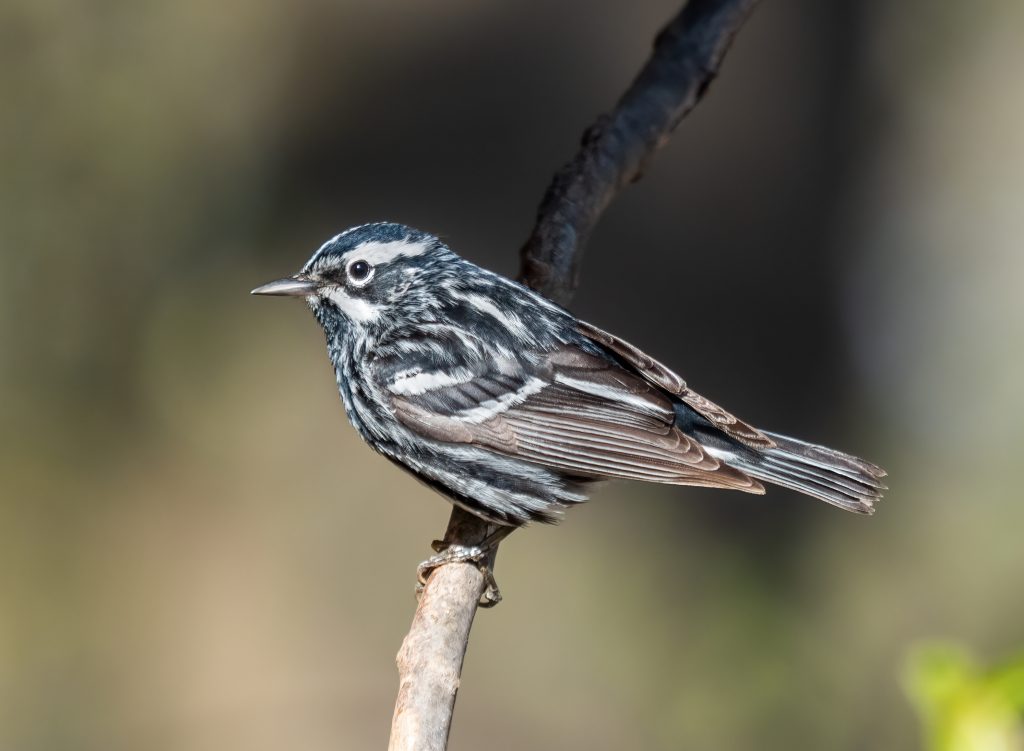
Black-and-white Warblers spend the winter season in southern Louisiana and can also be spotted during the breeding season in the northern parts of the state. Their numbers increase
during the spring and fall migration.
These distinctive warblers display a unique striped pattern. Male Black-and-white Warblers feature a large black patch across the eye and cheek, and their black coloration is darker compared to females.
Scientific Name: Mniotilta varia
Length: 4.3-5.1 in (11-13 cm)
Weight: 0.3-0.5 oz (8-15 g)
Wingspan: 7.1-8.7 in (18-22 cm)
Black-and-white Warblers breed in the eastern United States and Canada. During winter, they can be found in Florida, along the Gulf Coast, Mexico, Baja California, the Caribbean, and northern South America. They also make appearances during migration in central US states.
These delightful birds can be observed hopping up and down on tree trunks and branches in forests, foraging for insects.
Immerse yourself in the charming song of the Black-and-white Warbler. Listen to the recording by Christopher McPherson, accessible at www.xeno-canto.org/600300.
Nests of Black-and-white Warblers are concealed close to or on the ground, often under logs or shrubs. Constructed from bark, grass, pine needles, and woven together, the nests provide a secure cup-shaped structure. They lay around five eggs, which hatch after an incubation period of approximately eleven days. The fledglings leave the nest within ten days.
9. Yellow Warbler

Yellow Warblers pass through Louisiana during the spring and fall migration, with a few individuals remaining during winter.
These small, brightly colored birds showcase vibrant yellow plumage with a yellow-green back. Male Yellow Warblers possess chestnut streaks on their breasts, while females and juveniles lack these streaks and exhibit a slightly paler plumage.
Scientific Name: Setophaga petechia
Length: 4.7-5.1 in (12-13 cm)
Weight: 0.3-0.4 oz (9-11 g)
Wingspan: 6.3-7.9 in (16-20 cm)
Yellow Warblers undertake long-distance migrations to breed in Canada and the United States, excluding southeastern states. They subsequently embark on journeys to Central and South America for winter. During migration, they can be observed in southeastern US states.
These charming birds can be found near streams, wetlands, thickets, and field edges, foraging on insects such as caterpillars, midges, beetles, bugs, and wasps.
Indulge in the melodious song of the Yellow Warbler. Listen to the recording by Richard E. Webster, accessible at www.xeno-canto.org/662546.
Nests of Yellow Warblers are built in small trees or shrubs, constructed from bark, grass, and plant material woven together, and secured with spider webs. The nest is then lined with softer materials like hair, feathers, and plant down.
They lay up to seven eggs, which incubate for approximately twelve days, followed by ten days for the fledglings to leave the nest.
To attract Yellow Warblers to your backyard, provide suet, oranges, peanut butter, and plants with berries. Create an insect-friendly environment by planting native plants without the use of pesticides and maintaining natural habitats. Birdbaths with fountains, placed near secluded areas with vegetation, offer additional protection.
Fun Fact: Yellow Warblers often fall victim to brood parasitism by cowbirds. In response, the Yellow Warblers may build new nests on top of the old ones, attempting to outwit the parasitic birds. This process can be repeated up to six times!
10. American Redstart
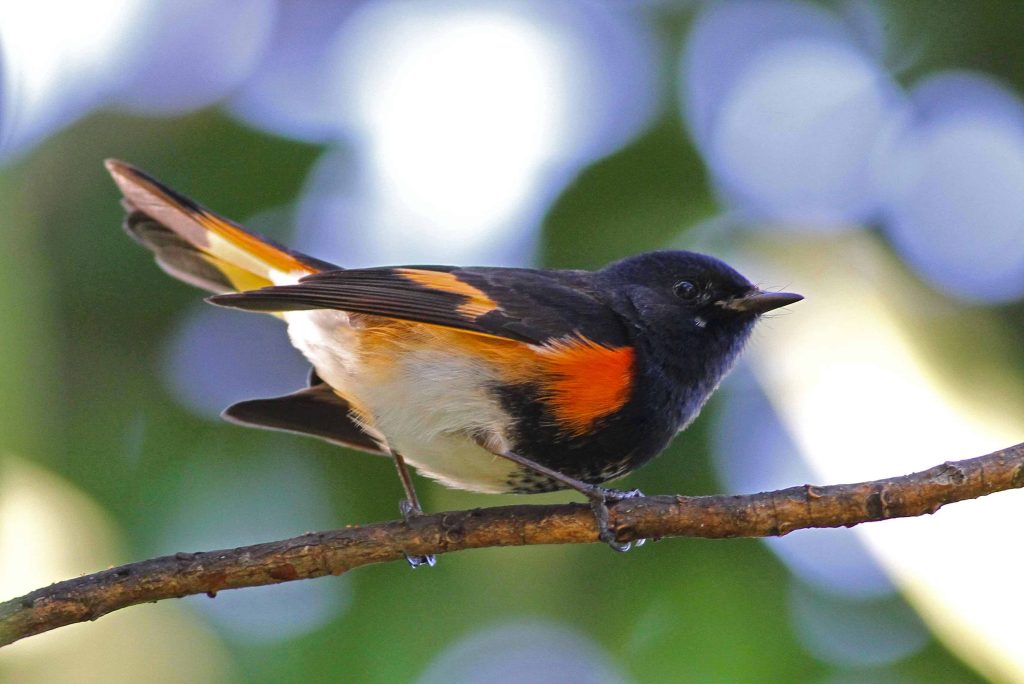
American Redstarts spend the breeding season in Louisiana, with more frequent sightings during migration from September to October. They feature in 3% of summer checklists and up to 20% of checklists during the fall migration.
These striking warblers predominantly display black plumage with vibrant orange patches and a white belly. Females, on the other hand, exhibit olive-gray plumage without the black coloration, along with yellow patches.
Scientific Name: Setophaga ruticilla
Length: 4.3-5.1 in (11-13 cm)
Weight: 0.2-0.3 oz (6-9 g)
Wingspan: 6.3-7.5 in (16-19 cm)
American Redstarts breed in eastern US states, Canada, and northwestern US states. They can also be observed during migration in central and western US states.
These captivating birds can be found in deciduous woodlands, where they feed on insects. They are also known to frequent backyards and thickets, enjoying the berries of serviceberry and magnolia.
Listen to the enchanting song of the American Redstart. Tune in to the recording by Nick Kiehl, accessible at www.xeno-canto.org/522368.
Nests of American Redstarts are located near the trunk of trees or large shrubs. They are skillfully crafted using bark, grass, and plant materials. They lay up to five eggs, which incubate for just under two weeks, followed by a week or two for the fledglings to leave the nest.
To attract American Redstarts to your backyard, consider planting berry-bearing plants such as magnolia and serviceberry.
Fun Fact: American Redstart parents selectively feed specific chicks, rather than providing equal care to all.
11. Tennessee Warbler
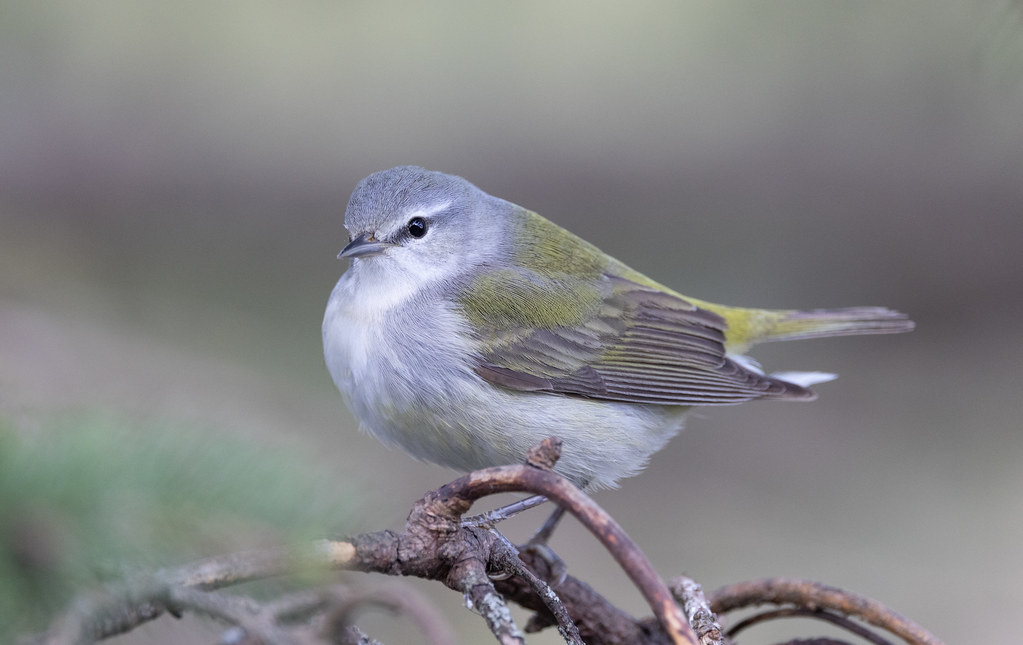
Tennessee Warblers pass through Louisiana during migration, particularly in the spring and fall. Their sightings are relatively common, and they can be found in various habitats during these seasons.
These warblers have a plain appearance, with olive-green upperparts and pale underparts. They exhibit a faint grayish head pattern and a white eye-ring.
Scientific Name: Leiothlypis peregrina
Length: 4.3-4.7 in (11-12 cm)
Weight: 0.2-0.3 oz (5-9 g)
Wingspan: 7.1-7.5 in (18-19 cm)
Tennessee Warblers breed in the boreal forests of Canada and Alaska. During migration, they can be observed in central and eastern US states.
These small birds prefer mixed forests and coniferous habitats during their journey. They feed on insects, especially during the breeding season, but they also consume fruits and berries.
Listen to the distinctive song of the Tennessee Warbler. Tune in to the recording by Pascal Vagner, accessible at www.xeno-canto.org/563902.
12. Magnolia Warbler
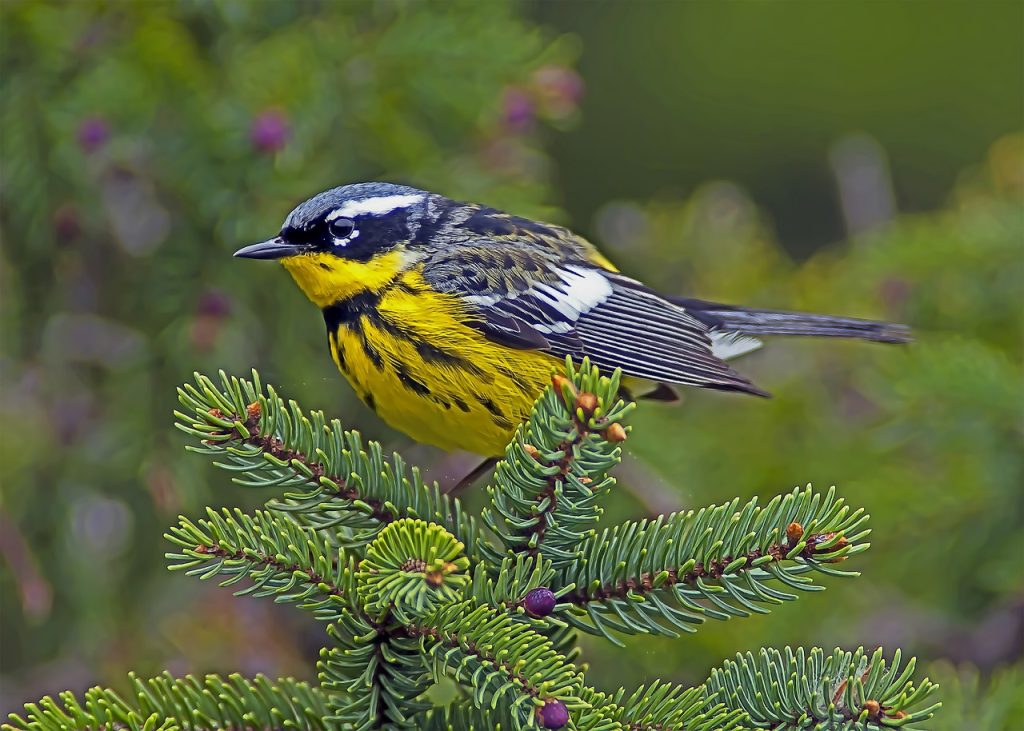
Magnolia Warblers migrate through Louisiana, particularly during the spring and fall seasons. They are relatively common, and their striking appearance makes them easy to spot.
These warblers showcase a bold pattern, with black streaks on a bright yellow body. They have a white underbelly and a black necklace-like band across their chest.
Scientific Name: Setophaga magnolia
Length: 4.3-5.1 in (11-13 cm)
Weight: 0.3-0.4 oz (8-11 g)
Wingspan: 7.1-8.3 in (18-21 cm)
Magnolia Warblers breed in the boreal forests of Canada and Alaska. During migration, they can be observed in the eastern United States.
These birds prefer mixed woodlands, especially areas with coniferous and deciduous trees. They forage for insects, spiders, and caterpillars among the tree branches.
Indulge in the melodious song of the Magnolia Warbler. Listen to the recording by Richard E. Webster, accessible at www.xeno-canto.org/390123.
13. Bay-breasted Warbler
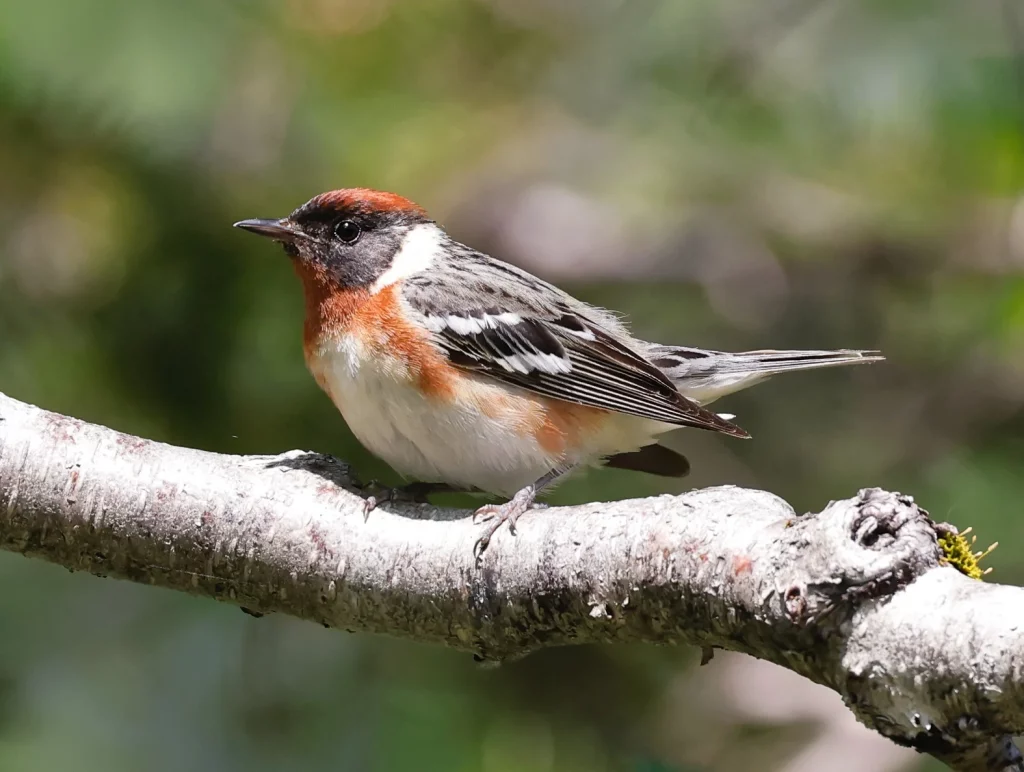
Bay-breasted Warblers pass through Louisiana during migration, primarily in the spring and fall. Although their sightings are less common, they can still be observed in suitable habitats.
These warblers possess a unique appearance, featuring a black face and throat, reddish-brown upperparts, and a pale underbelly. They also exhibit a distinctive patch of reddish-brown on their sides.
Scientific Name: Setophaga castanea
Length: 4.7-5.1 in (12-13 cm)
Weight: 0.3-0.4 oz (9-11 g)
Wingspan: 7.1-8.3 in (18-21 cm)
Bay-breasted Warblers breed in the boreal forests of Canada. During migration, they can be observed in the northeastern and central United States.
These birds primarily inhabit coniferous forests during their journey. They feed on insects, spiders, and caterpillars found among the tree branches.
Listen to the melodious song of the Bay-breasted Warbler. Tune in to the recording by Tom Johnson, accessible at www.xeno-canto.org/576213.
14. Blackburnian Warbler
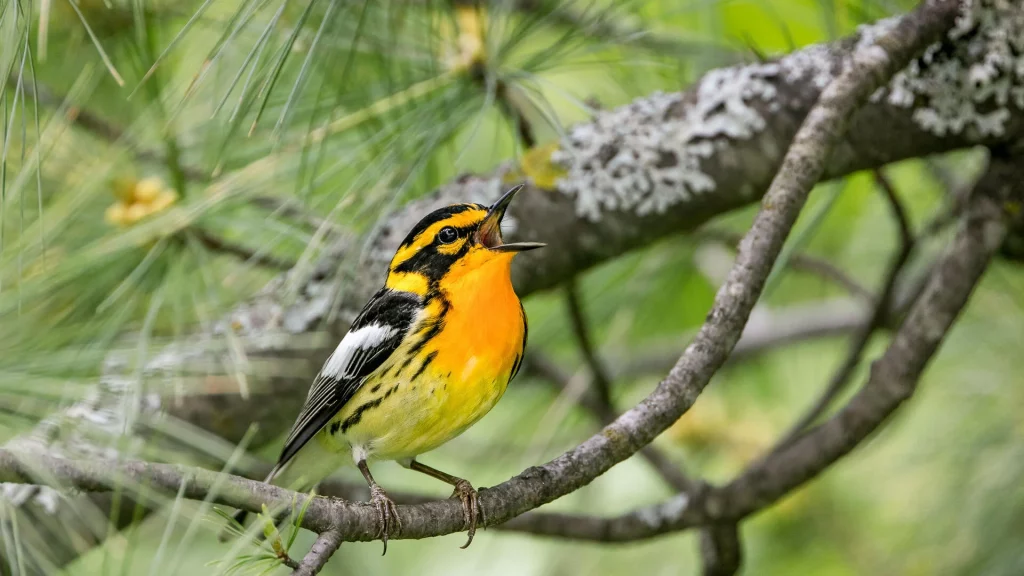
Blackburnian Warblers migrate through Louisiana during the spring and fall, with occasional sightings in suitable habitats. Their striking appearance and unique song make them a sought-after species.
These warblers display vibrant orange throats and upperparts, contrasting with black wings and a white belly. They have bold black streaks on their back and a distinctive black face mask.
Scientific Name: Setophaga fusca
Length: 4.3-4.7 in (11-12 cm)
Weight: 0.3-0.4 oz (8-11 g)
Wingspan: 7.5-8.7 in (19-22 cm)
Blackburnian Warblers breed in the boreal forests of Canada and the northeastern United States. During migration, they can be observed in eastern US states.
These birds primarily inhabit coniferous and mixed woodlands during their journey. They forage for insects and spiders among the tree branches.
Immerse yourself in the beautiful song of the Blackburnian Warbler. Listen to the recording by Richard E. Webster, accessible at www.xeno-canto.org/390116.
15. Yellow-throated Warbler
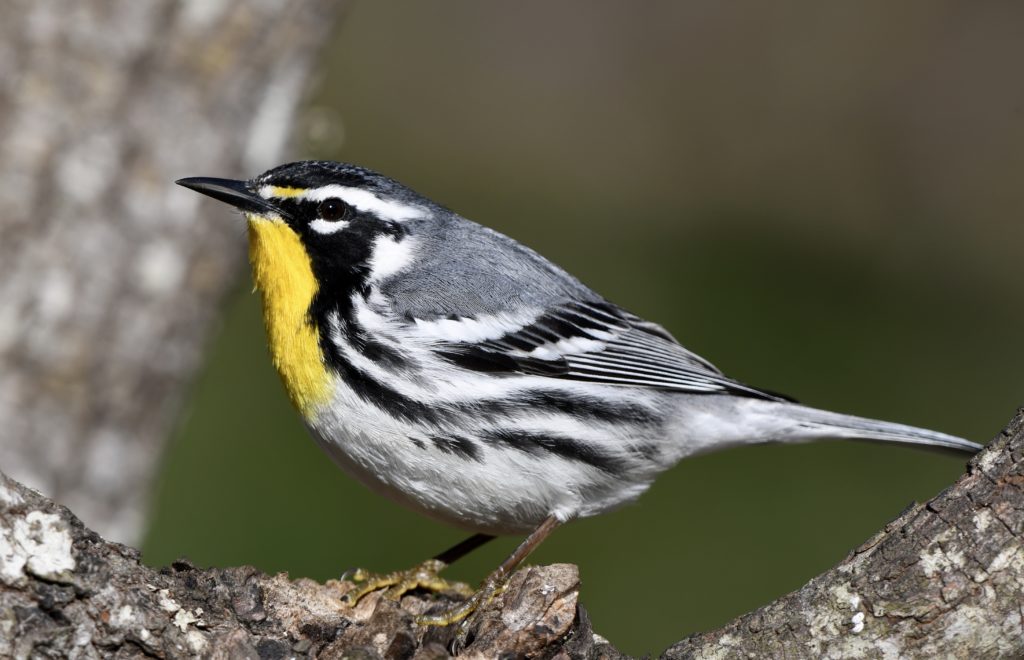
Yellow-throated Warblers can be found in Louisiana during the breeding season, as they are regular residents in suitable habitats. Their striking appearance and distinct song make them a treat to observe.
These warblers display a yellow throat and upper chest, contrasting with gray upperparts and a white belly. They have black streaks on their sides and distinctive black eye-lines.
Scientific Name: Setophaga dominica
Length: 4.7-5.5 in (12-14 cm)
Weight: 0.3-0.4 oz (9-11 g)
Wingspan: 8.3-9.4 in (21-24 cm)
Yellow-throated Warblers breed in the southeastern United States, including Louisiana. They prefer forested habitats with mature trees and can be found near water bodies.
These birds forage for insects, spiders, and caterpillars among the tree branches. They also consume small fruits and berries.
Listen to the delightful song of the Yellow-throated Warbler. Tune in to the recording by Paul Marvin, accessible at www.xeno-canto.org/625069.
16. Cerulean Warbler
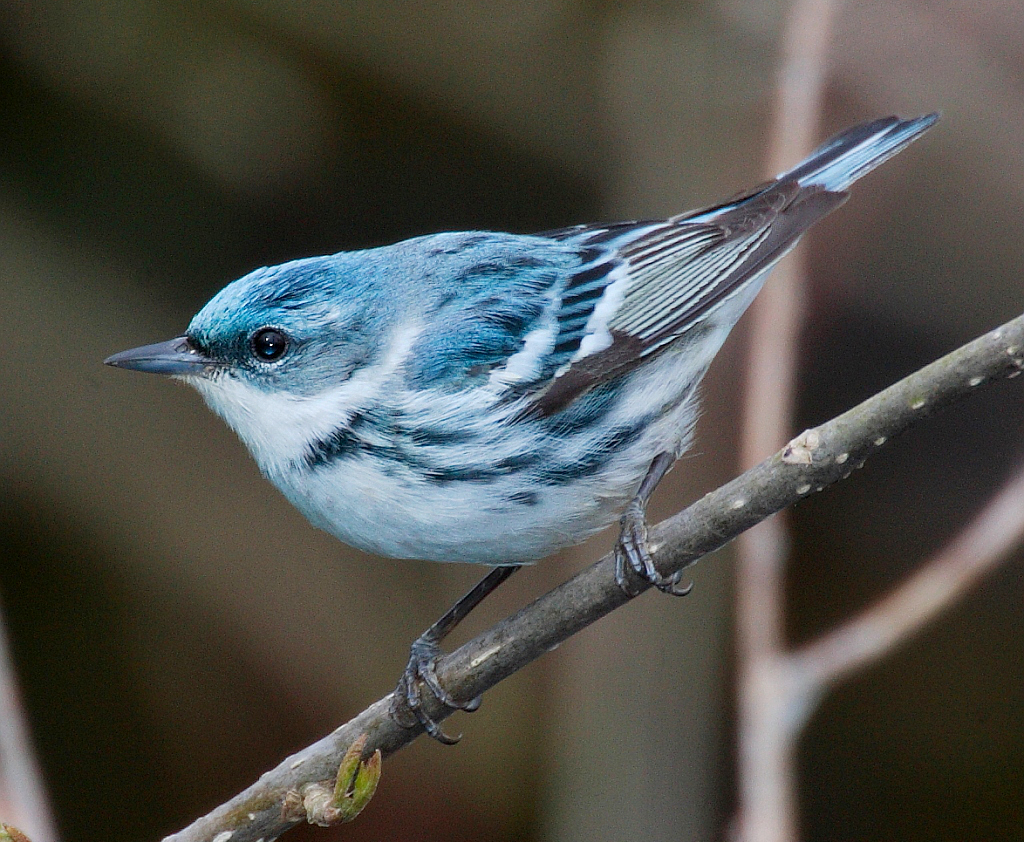
Cerulean Warblers migrate through Louisiana during the spring and fall seasons, with occasional sightings in suitable habitats. They are relatively uncommon but highly sought after by birdwatchers.
These warblers feature a stunning cerulean blue coloration on their upperparts, complemented by a white belly. Males possess a black necklace-like band across their chest.
Scientific Name: Setophaga cerulea
Length: 4.3-4.7 in (11-12 cm)
Weight: 0.3-0.4 oz (8-11 g)
Wingspan: 7.5-8.7 in (19-22 cm)
Cerulean Warblers breed in the eastern United States, including parts of the Mississippi Alluvial Valley. During migration, they can be observed in the southeastern and central United States.
These birds primarily inhabit mature deciduous forests during their journey. They forage for insects and caterpillars among the tree branches.
Indulge in the melodious song of the Cerulean Warbler. Listen to the recording by Richard E. Webster, accessible at www.xeno-canto.org/390082.
17. Golden-winged Warbler
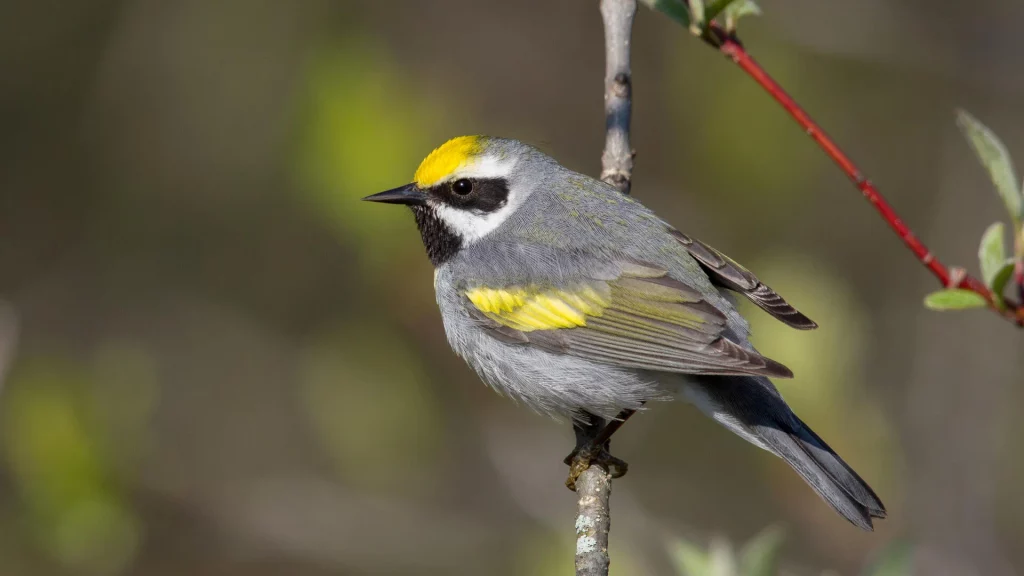
Golden-winged Warblers pass through Louisiana during migration, particularly in the spring and fall seasons. Their sightings are relatively uncommon but can occur in suitable habitats.
These warblers feature a distinctive pattern, with bright yellow plumage on their head and wings, complemented by gray upperparts and a white belly. They also have a black patch near their eyes and a black throat.
Scientific Name: Vermivora chrysoptera
Length: 4.3-5.1 in (11-13 cm)
Weight: 0.3-0.4 oz (8-11 g)
Wingspan: 6.7-7.9 in (17-20 cm)
Golden-winged Warblers breed in parts of the northeastern and north-central United States. During migration, they can be observed in the eastern and central United States.
These birds prefer early successional habitats, including shrubby areas and young forests. They forage for insects and spiders among the vegetation.
Listen to the captivating song of the Golden-winged Warbler. Tune in to the recording by Andrew Spencer, accessible at www.xeno-canto.org/553047.
18. Chestnut-sided Warbler
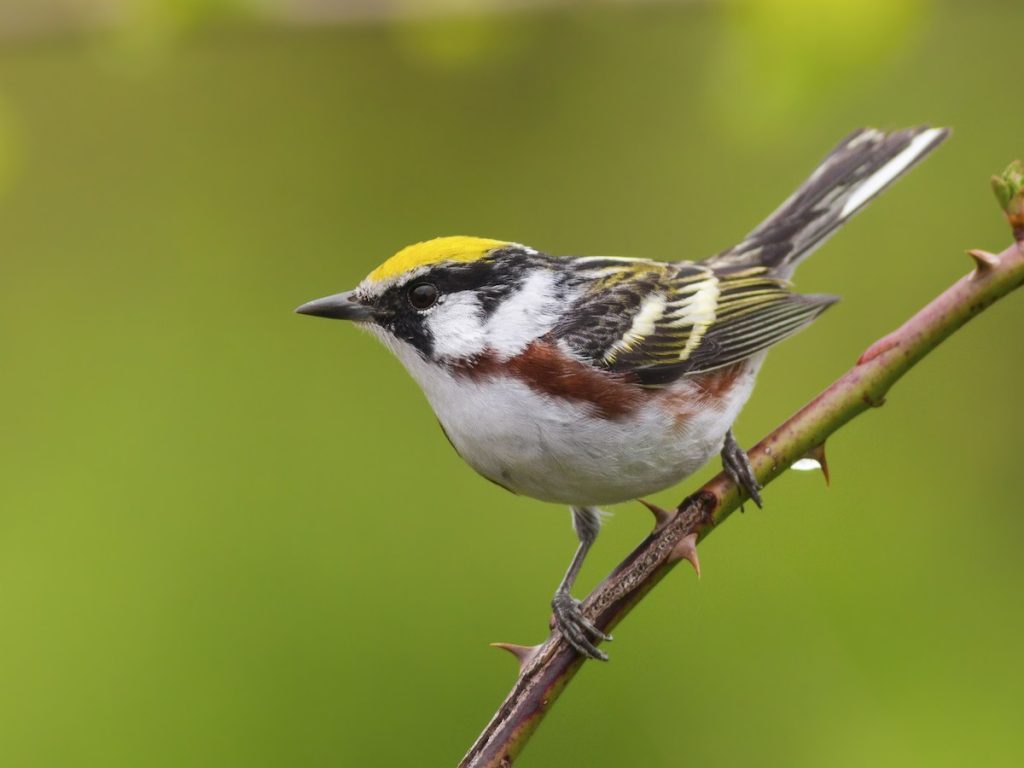
Chestnut-sided Warblers migrate through Louisiana during the spring and fall seasons, with occasional sightings in suitable habitats. They are known for their distinct plumage and beautiful song.
These warblers display vibrant chestnut-colored patches on their sides, contrasting with yellow underparts and a grayish back. Males possess bold black streaks on their cap and a white eye-ring.
Scientific Name: Setophaga pensylvanica
Length: 4.3-4.7 in (11-12 cm)
Weight: 0.3-0.4 oz (8-11 g)
Wingspan: 7.1-8.3 in (18-21 cm)
Chestnut-sided Warblers breed in the northeastern United States and parts of Canada. During migration, they can be observed in the eastern and central United States.
These birds primarily inhabit deciduous forests and brushy areas during their journey. They forage for insects, caterpillars, and spiders among the vegetation.
Immerse yourself in the melodious song of the Chestnut-sided Warbler. Listen to the recording by Andrew Spencer, accessible at www.xeno-canto.org/650319.
19. Blue-winged Warbler
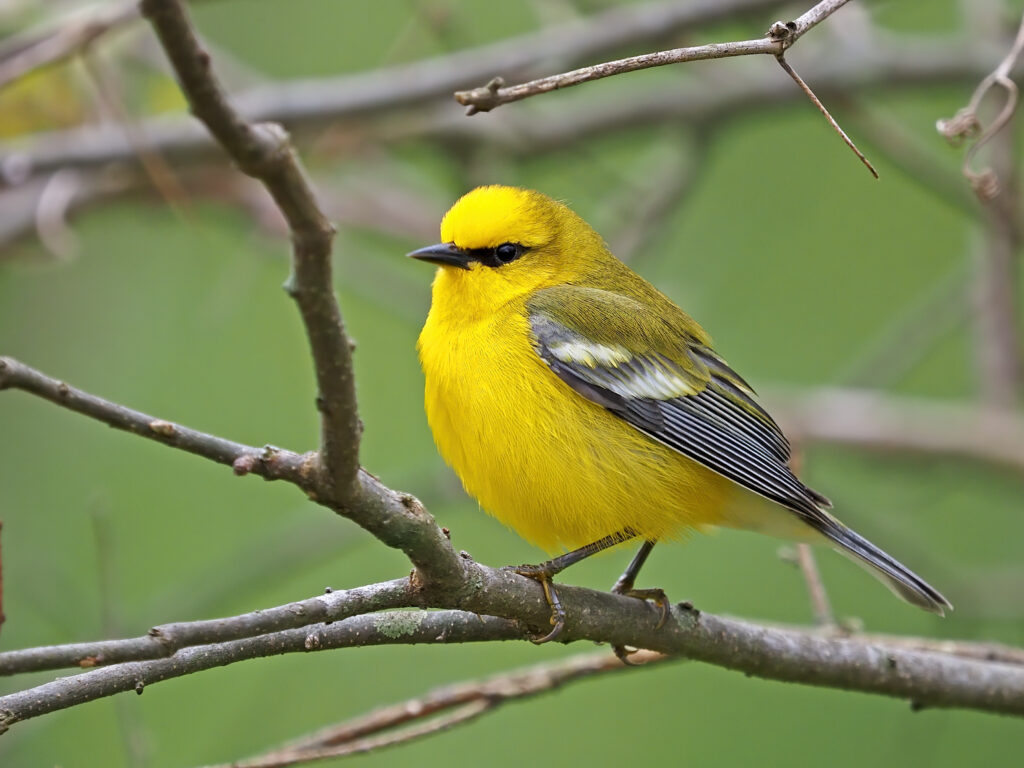
Blue-winged Warblers pass through Louisiana during migration, primarily in the spring and fall seasons. Their sightings are relatively uncommon but can occur in suitable habitats.
These warblers exhibit a striking appearance, with bright yellow underparts and a yellow face. Males possess a blue-gray coloration on their wings, while females have a duller greenish-gray wing color.
Scientific Name: Vermivora cyanoptera
Length: 4.3-4.7 in (11-12 cm)
Weight: 0.3-0.4 oz (8-11 g)
Wingspan: 6.7-7.9 in (17-20 cm)
Blue-winged Warblers breed in the northeastern and central United States. During migration, they can be observed in the eastern and central United States.
These birds prefer shrubby habitats, including young forests and brushy areas. They forage for insects and spiders among the vegetation.
Listen to the delightful song of the Blue-winged Warbler. Tune in to the recording by Andrew Spencer, accessible at www.xeno-canto.org/598622.
20. Mourning Warbler
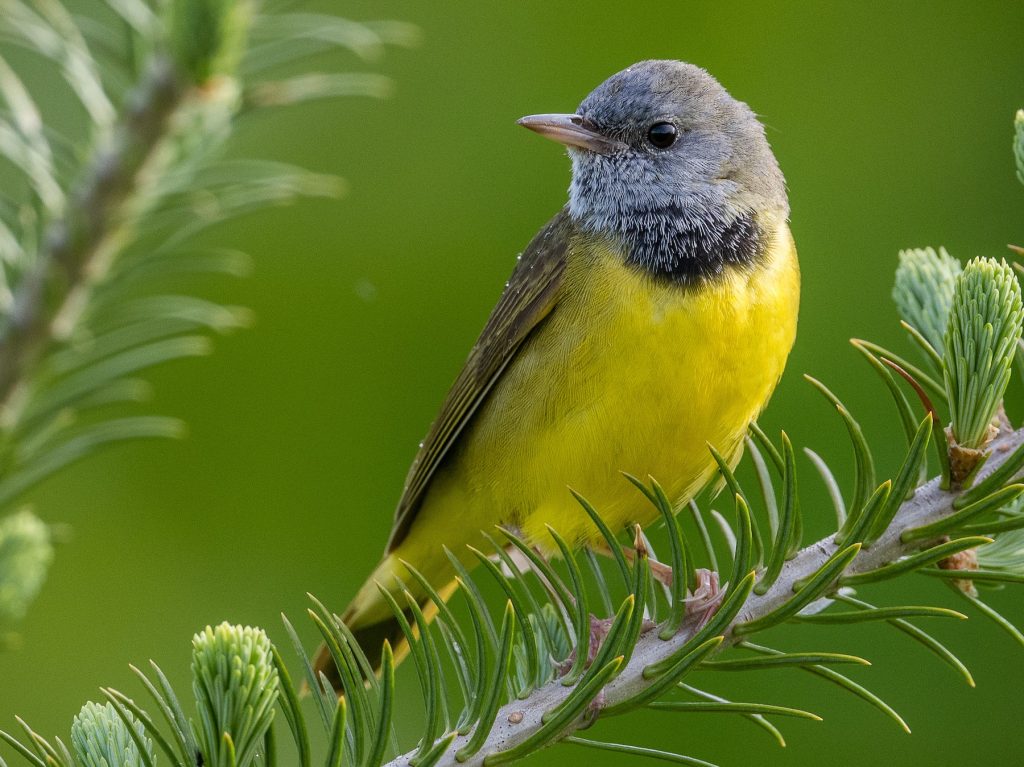
Mourning Warblers migrate through Louisiana during the spring and fall seasons, with occasional sightings in suitable habitats. They are relatively uncommon but can be observed by attentive birdwatchers.
These warblers possess a subtle yet distinctive appearance, with a gray head and back, complemented by a yellow underbelly. They have a black necklace-like band across their chest.
Scientific Name: Geothlypis philadelphia
Length: 4.3-4.7 in (11-12 cm)
Weight: 0.3-0.4 oz (8-11 g)
Wingspan: 7.5-8.7 in (19-22 cm)
Mourning Warblers breed in the northeastern United States and parts of Canada. During migration, they can be observed in the eastern and central United States.
These birds primarily inhabit dense undergrowth in deciduous forests and shrubby areas. They forage for insects and spiders close to the ground.
Indulge in the beautiful song of the Mourning Warbler. Listen to the recording by Andrew Spencer, accessible at www.xeno-canto.org/650323.
21. Black-throated Blue Warbler

Black-throated Blue Warblers migrate through Louisiana during the spring and fall seasons, with occasional sightings in suitable habitats. Their sightings are relatively uncommon, but their striking appearance makes them easily recognizable.
These warblers display a bold contrast of black and blue plumage. Males possess a black throat and upperparts, with a vibrant blue coloration on their wings and back. Females have a more subdued grayish-green coloration.
Scientific Name: Setophaga caerulescens
Length: 4.7-5.1 in (12-13 cm)
Weight: 0.3-0.4 oz (9-11 g)
Wingspan: 7.5-8.7 in (19-22 cm)
Black-throated Blue Warblers breed in the northeastern United States and parts of Canada. During migration, they can be observed in the eastern and central United States.
These birds primarily inhabit mature deciduous forests during their journey. They forage for insects and spiders among the tree branches.
Immerse yourself in the melodious song of the Black-throated Blue Warbler. Listen to the recording by Andrew Spencer, accessible at www.xeno-canto.org/650321.
22. Yellow-breasted Chat
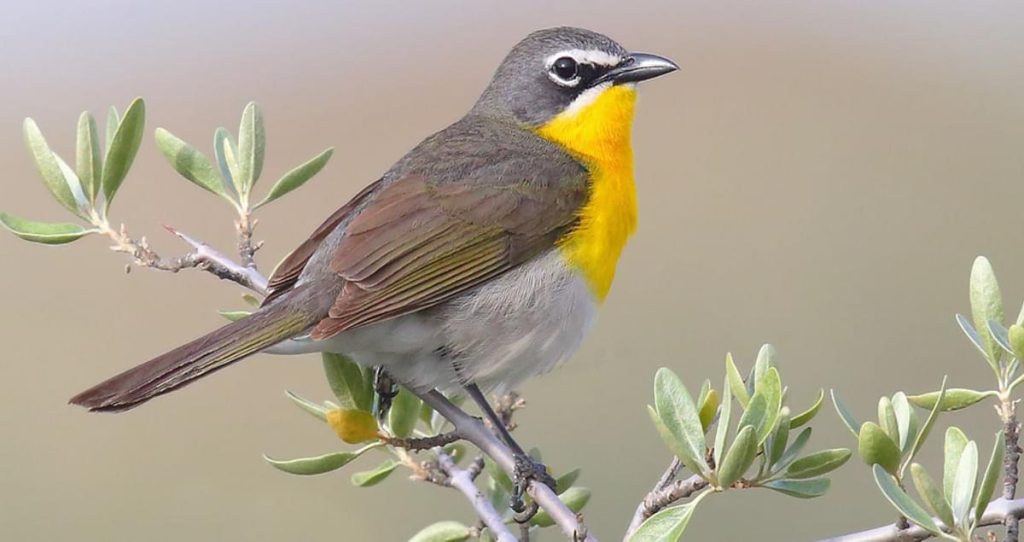
Yellow-breasted Chats breed in Louisiana and are regular residents in suitable habitats. They are known for their unique appearance and distinct vocalizations.
These birds possess a striking and somewhat unusual plumage. They have a yellow underbelly, olive-green upperparts, and a distinctive white eye-ring. Their bill is thick and slightly curved.
Scientific Name: Icteria virens
Length: 7.1-7.9 in (18-20 cm)
Weight: 1.0-1.6 oz (29-45 g)
Wingspan: 8.7-9.8 in (22-25 cm)
Yellow-breasted Chats breed in shrubby habitats, including thickets, brushy areas, and wetlands. They are often found in dense vegetation and can be challenging to spot.
These birds have a complex and varied vocal repertoire, consisting of a series of melodious and harsh notes. Their songs are often described as jumbled and mimic the sounds of other birds.
Listen to the distinct vocalizations of the Yellow-breasted Chat. Tune in to the recording by Richard E. Webster, accessible at www.xeno-canto.org/389652.
23. Swainson’s Warbler
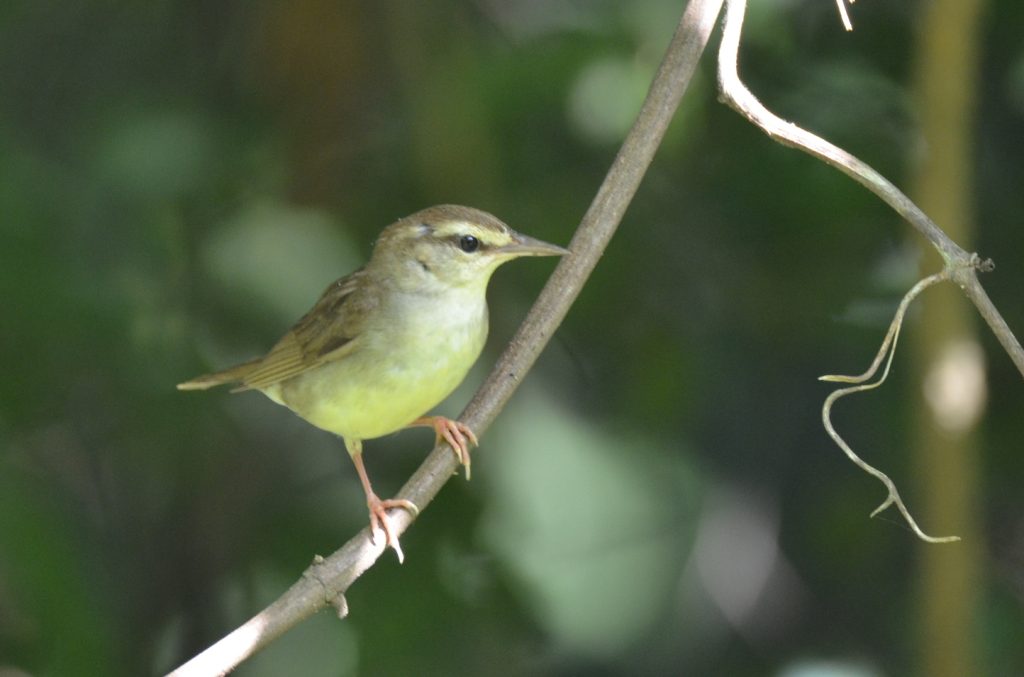
Swainson’s Warblers breed in Louisiana and are regular residents in suitable habitats. They are known for their secretive behavior and unique song.
These warblers have a relatively plain appearance, with brownish upperparts and a pale underbelly. They possess a distinctive white eyebrow stripe and a long bill.
Scientific Name: Limnothlypis swainsonii
Length: 5.1-5.5 in (13-14 cm)
Weight: 0.4-0.6 oz (12-17 g)
Wingspan: 7.9-8.7 in (20-22 cm)
Swainson’s Warblers prefer dense understory habitats, such as bottomland hardwood forests and swampy areas. They often stay hidden in thick vegetation and are challenging
to observe.
These birds have a loud and rich song, consisting of a series of musical phrases. Their song is often described as ventriloquial, as it seems to come from different directions.
Listen to the unique song of the Swainson’s Warbler. Tune in to the recording by Andrew Spencer, accessible at www.xeno-canto.org/650365.
24. Connecticut Warbler
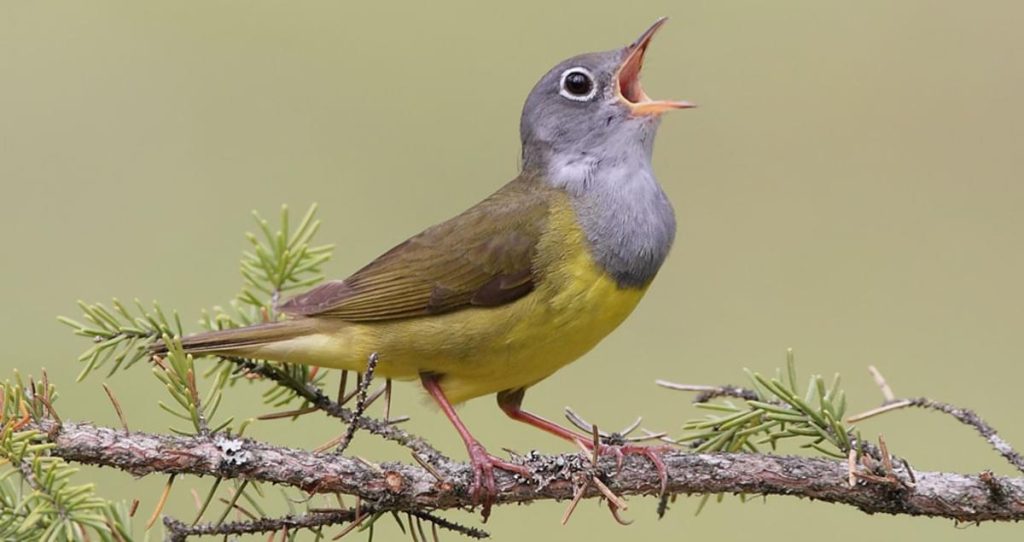
Connecticut Warblers migrate through Louisiana during the spring and fall seasons, with occasional sightings in suitable habitats. They are relatively uncommon and secretive birds.
These warblers have a plain appearance, with olive-brown upperparts and a pale underbelly. They possess a distinctive gray hood and a white eye-ring.
Scientific Name: Oporornis agilis
Length: 5.5-6.3 in (14-16 cm)
Weight: 0.5-0.7 oz (15-20 g)
Wingspan: 7.9-9.1 in (20-23 cm)
Connecticut Warblers breed in the boreal forests of Canada and Alaska. During migration, they can be observed in the eastern and central United States.
These birds prefer moist thickets and wetland habitats, often near water bodies. They forage for insects and spiders close to the ground.
Listen to the song of the Connecticut Warbler. Tune in to the recording by Andrew Spencer, accessible at www.xeno-canto.org/650367.
25. Kentucky Warbler
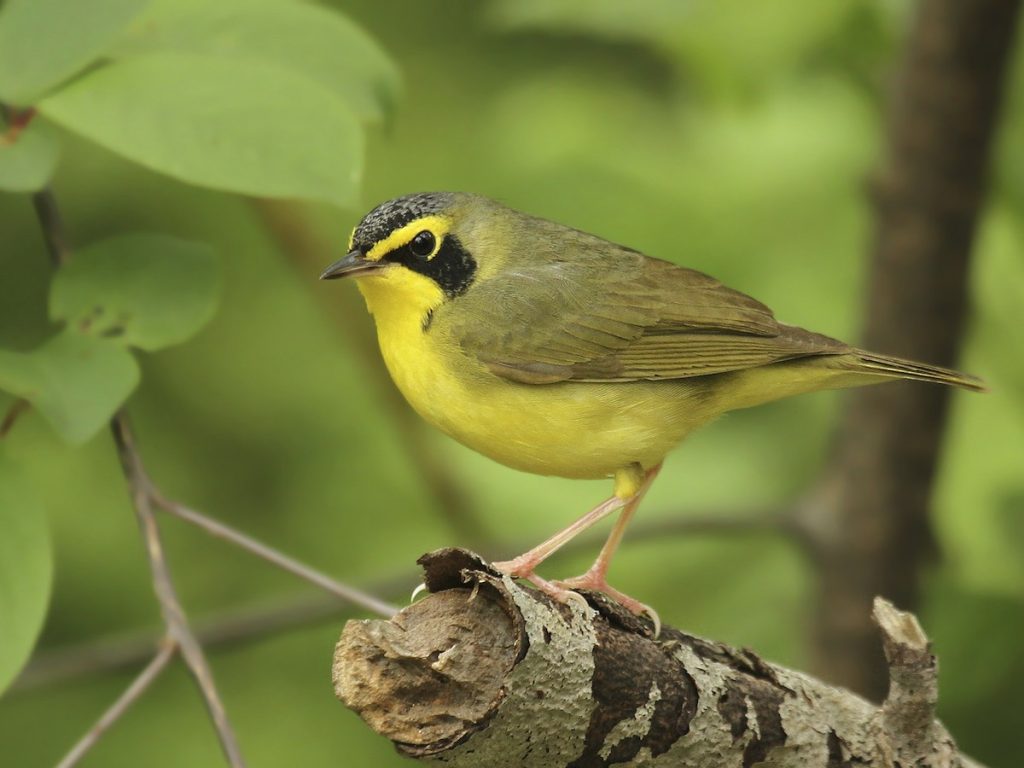
Kentucky Warblers breed in Louisiana and are regular residents in suitable habitats. They are known for their bright yellow plumage and distinct song.
These warblers have a striking appearance, with yellow underparts and olive-green upperparts. They possess a black mask across their face and a distinctive black necklace-like band.
Scientific Name: Geothlypis formosa
Length: 5.5-5.9 in (14-15 cm)
Weight: 0.5-0.7 oz (15-20 g)
Wingspan: 8.3-9.1 in (21-23 cm)
Kentucky Warblers prefer deciduous forests with dense understory vegetation. They forage for insects and spiders on or near the ground.
These birds have a loud and distinctive song that consists of a series of rolling phrases. Their song is often described as “tea-kettle, tea-kettle, tea-kettle.”
Listen to the beautiful song of the Kentucky Warbler. Tune in to the recording by Andrew Spencer, accessible at www.xeno-canto.org/650370.
26. Worm-eating Warbler
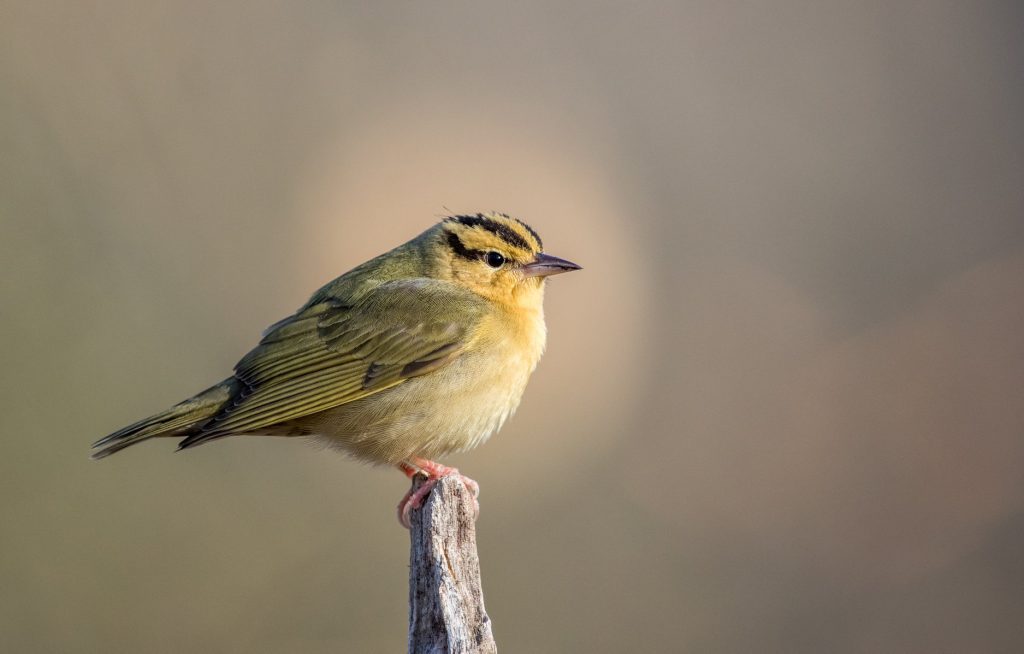
Worm-eating Warblers breed in Louisiana and are regular residents in suitable habitats. They are known for their unique appearance and distinct vocalizations.
These warblers have a brownish-gray upperparts and a pale underbelly. They possess distinct black stripes on their head and a long bill.
Scientific Name: Helmitheros vermivorus
Length: 5.5-5.9 in (14-15 cm)
Weight: 0.4-0.6 oz (12-17 g)
Wingspan: 8.7-9.4 in (22-24 cm)
Worm-eating Warblers prefer mature deciduous forests with a dense understory. They forage for insects and spiders among the leaf litter on the forest floor.
These birds have a unique and buzzy song that is often described as an insect-like trill. Their vocalizations are an essential way of identifying them.
Listen to the distinct vocalizations of the Worm-eating Warbler. Tune in to the recording by Andrew Spencer, accessible at www.xeno-canto.org/650378.
27. Prothonotary Warbler

Prothonotary Warblers breed in Louisiana and are regular residents in suitable habitats. They are known for their vibrant yellow plumage and distinctive song.
These warblers display a bright yellow coloration on their head, back, and underparts. They possess a distinctive blue-gray coloration on their wings and a long bill.
Scientific Name: Protonotaria citrea
Length: 4.7-5.1 in (12-13 cm)
Weight: 0.4-0.5 oz (11-14 g)
Wingspan: 7.9-8.7 in (20-22 cm)
Prothonotary Warblers prefer swampy habitats, including bottomland forests and wetlands with standing water. They often nest in tree cavities or nest boxes near water bodies.
These birds have a loud and ringing song that is often described as a series of rolling notes. Their song is an unmistakable sound of wetland habitats.
Listen to the beautiful song of the Prothonotary Warbler. Tune in to the recording by Andrew Spencer, accessible at www.xeno-canto.org/650377.
28. Louisiana Waterthrush
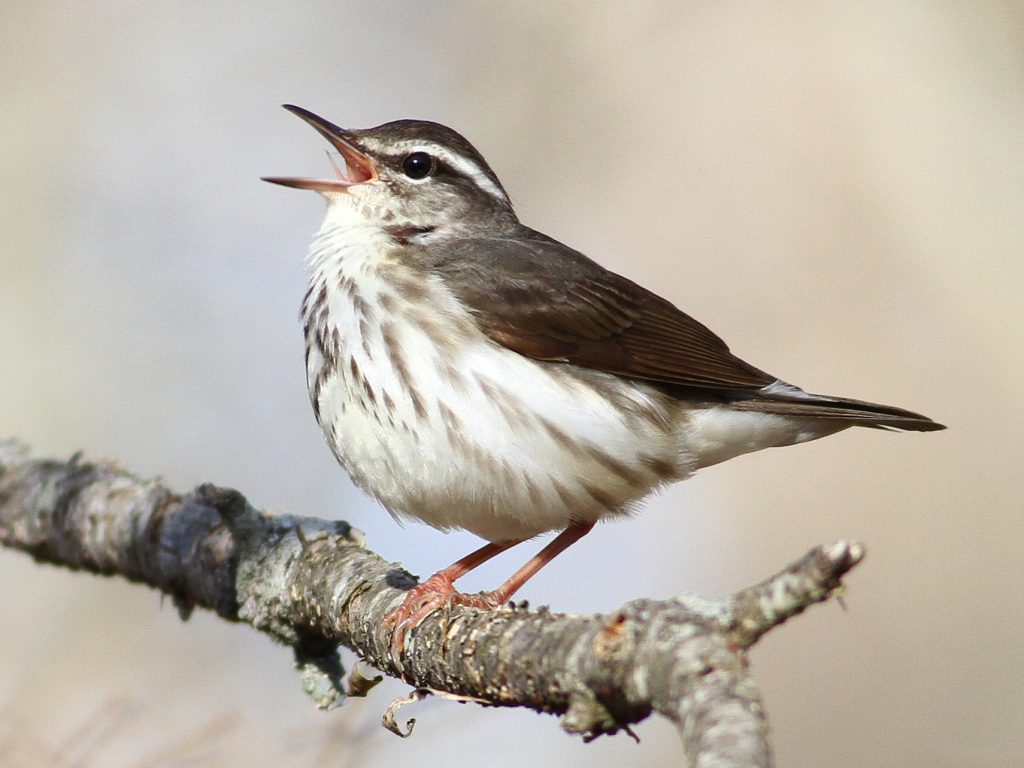
Louisiana Waterthrushes breed in Louisiana and are regular residents in suitable habitats. They are known for their distinctive behavior and beautiful song.
These warblers have a brownish upperparts and a white underbelly with streaks on the chest. They possess a long bill and pink legs.
Scientific Name: Parkesia motacilla
Length: 5.1-5.9 in (13-15 cm)
Weight: 0.5-0.6 oz (15-17 g)
Wingspan: 8.7-9.4 in (22-24 cm)
Louisiana Waterthrushes prefer streams, rivers, and other freshwater habitats with rocky substrates. They forage for insects and small aquatic invertebrates by walking and bobbing their tails.
These birds have a loud and melodious song that is often described as a ringing “sweet-sweet-sweet.” Their song is a characteristic sound of riparian habitats.
Listen to the beautiful song of the Louisiana Waterthrush. Tune in to the recording by Andrew Spencer, accessible at www.xeno-canto.org/650375.
29. Northern Parula

Northern Parulas breed in Louisiana and are regular residents in suitable habitats. They are known for their small size and distinctive plumage.
These warblers have bluish-gray upperparts and a yellowish-green coloration on their underparts. Males possess a bluish-gray band across their chest and a distinctive orange patch on their back.
Scientific Name: Setophaga americana
Length: 4.3-4.7 in (11-12 cm)
Weight: 0.2-0.3 oz (5-9 g)
Wingspan: 7.1-7.5 in (18-19 cm)
Northern Parulas prefer mixed forests and swampy habitats. They forage for insects and spiders among the tree branches, often hanging upside-down to feed.
These birds have a distinctive and buzzy song that is often described as a rising trill followed by a sharp “chip.” Their vocalizations are a common sound in forested habitats.
Listen to the unique song of the Northern Parula. Tune in to the recording by Andrew Spencer, accessible at www.xeno-canto.org/650372.
30. Ovenbird

Ovenbirds breed in Louisiana and are regular residents in suitable habitats. They are known for their distinctive behavior and unique song.
These warblers have brown upperparts with dark streaks and a white underbelly with black streaks on the sides. They possess a bold white eye-ring and a long bill.
Scientific Name: Seiurus aurocapilla
Length: 5.5-6.3 in (14-16 cm)
Weight: 0.6-0.8 oz (17-23 g)
Wingspan: 7.9-8.7 in (20-22 cm)
Ovenbirds prefer dense deciduous forests with a thick leaf litter on the forest floor. They forage for insects and spiders by scratching and hopping on the ground.
These birds have a loud and distinctive song that is often described as a series of ringing “teacher-teacher-teacher.” Their vocalizations are a characteristic sound of mature forests.
Listen to the unique song of the Ovenbird. Tune in to the recording by Andrew Spencer, accessible at www.xeno-canto.org/650368.
31. Worm-eating Warbler

Worm-eating Warblers breed in Louisiana and are regular residents in suitable habitats. They are known for their unique appearance and distinct vocalizations.
These warblers have a brownish-gray upperparts and a pale underbelly. They possess distinct black stripes on their head and a long bill.
Scientific Name: Helmitheros vermivorus
Length: 5.5-5.9 in (14-15 cm)
Weight: 0.4-0.6 oz (12-17 g)
Wingspan: 8.7-9.4 in (22-24 cm)
Worm-eating Warblers prefer mature deciduous forests with a dense understory. They forage for insects and spiders among the leaf litter on the forest floor.
These birds have a unique and buzzy song that is often described as an insect-like trill. Their vocalizations are an essential way of identifying them.
Listen to the distinct vocalizations of the Worm-eating Warbler. Tune in to the recording by Andrew Spencer, accessible at www.xeno-canto.org/650378.
32. Blue-winged Warbler

Blue-winged Warblers pass through Louisiana during migration, primarily in the spring and fall seasons. Their sightings are relatively uncommon but can occur in suitable habitats.
These warblers exhibit a striking appearance, with bright yellow underparts and a yellow face. Males possess a blue-gray coloration on their wings, while females have a duller greenish-gray wing color.
Scientific Name: Vermivora cyanoptera
Length: 4.3-4.7 in (11-12 cm)
Weight: 0.3-0.4 oz (8-11 g)
Wingspan: 6.7-7.9 in (17-20 cm)
Blue-winged Warblers breed in the northeastern and central United States. During migration, they can be observed in the eastern and central United States.
These birds prefer shrubby habitats, including young forests and brushy areas. They forage for insects and spiders among the vegetation.
Listen to the delightful song of the Blue-winged Warbler. Tune in to the recording by Andrew Spencer, accessible at www.xeno-canto.org/598622.
33. Mourning Warbler
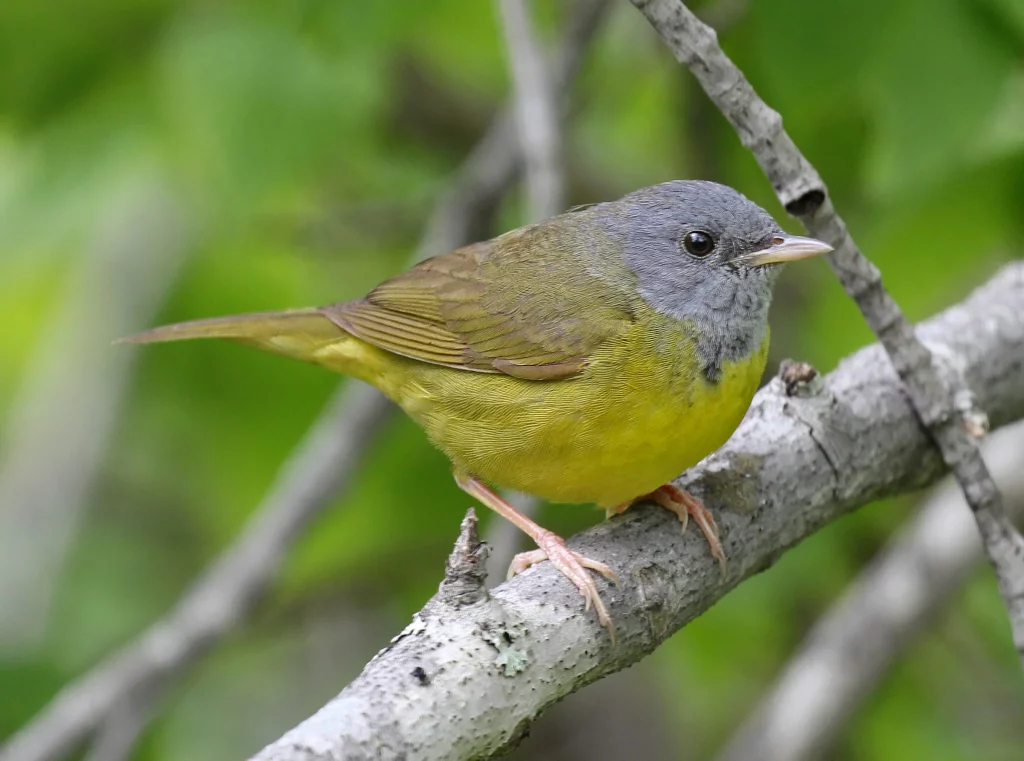
Mourning Warblers migrate through Louisiana during the spring and fall seasons, with occasional sightings in suitable habitats. They are relatively uncommon but can be observed by attentive birdwatchers.
These warblers possess a subtle yet distinctive appearance, with a gray head and back, complemented by a yellow underbelly. They have a black necklace-like band across their chest.
Scientific Name: Geothlypis philadelphia
Length: 4.3-4.7 in (11-12 cm)
Weight: 0.3-0.4 oz (8-11 g)
Wingspan: 7.5-8.7 in (19-22 cm)
Mourning Warblers breed in the northeastern United States and parts of Canada. During migration, they can be observed in the eastern and central United States.
These birds primarily inhabit dense undergrowth in deciduous forests and shrubby areas. They forage for insects and spiders close to the ground.
Indulge in the beautiful song of the Mourning Warbler. Listen to the recording by Andrew Spencer, accessible at www.xeno-canto.org/650323.
34. Black-throated Blue Warbler
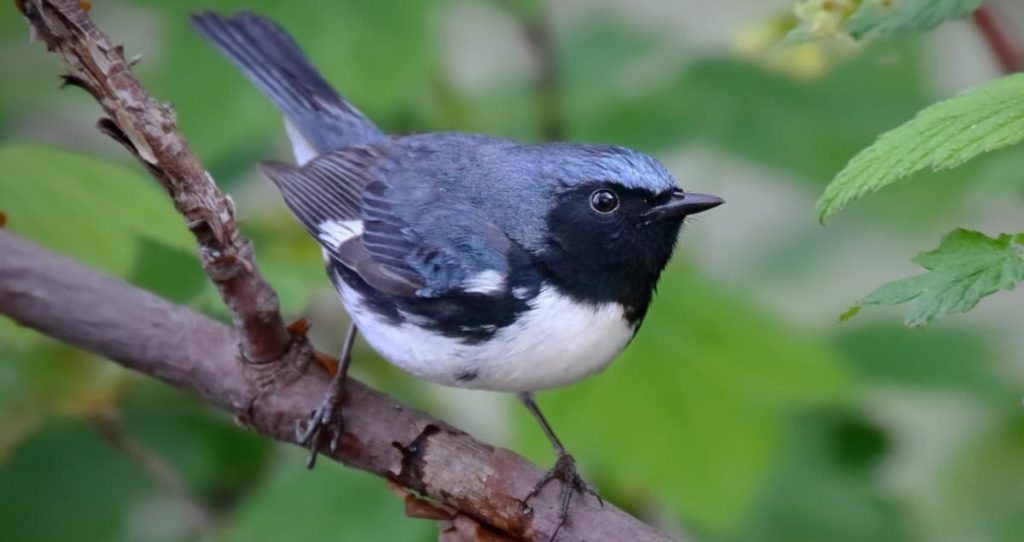
Black-throated Blue Warblers migrate through Louisiana during the spring and fall seasons, with occasional sightings in suitable habitats. Their sightings are relatively uncommon, but their striking appearance makes them easily recognizable.
These warblers display a bold contrast of black and blue plumage. Males possess a black throat and upperparts, with a vibrant blue coloration on their wings and back. Females have a more subdued grayish-green coloration.
Scientific Name: Setophaga caerulescens
Length: 4.7-5.1 in (12-13 cm)
Weight: 0.3-0.4 oz (9-11 g)
Wingspan: 7.5-8.7 in (19-22 cm)
Black-throated Blue Warblers breed in the northeastern United States and parts of Canada. During migration, they can be observed in the eastern and central United States.
These birds primarily inhabit mature deciduous forests during their journey. They forage for insects and spiders among the tree branches.
Immerse yourself in the melodious song of the Black-throated Blue Warbler. Listen to the recording by Andrew Spencer, accessible at www.xeno-canto.org/650321.
35. Yellow-breasted Chat
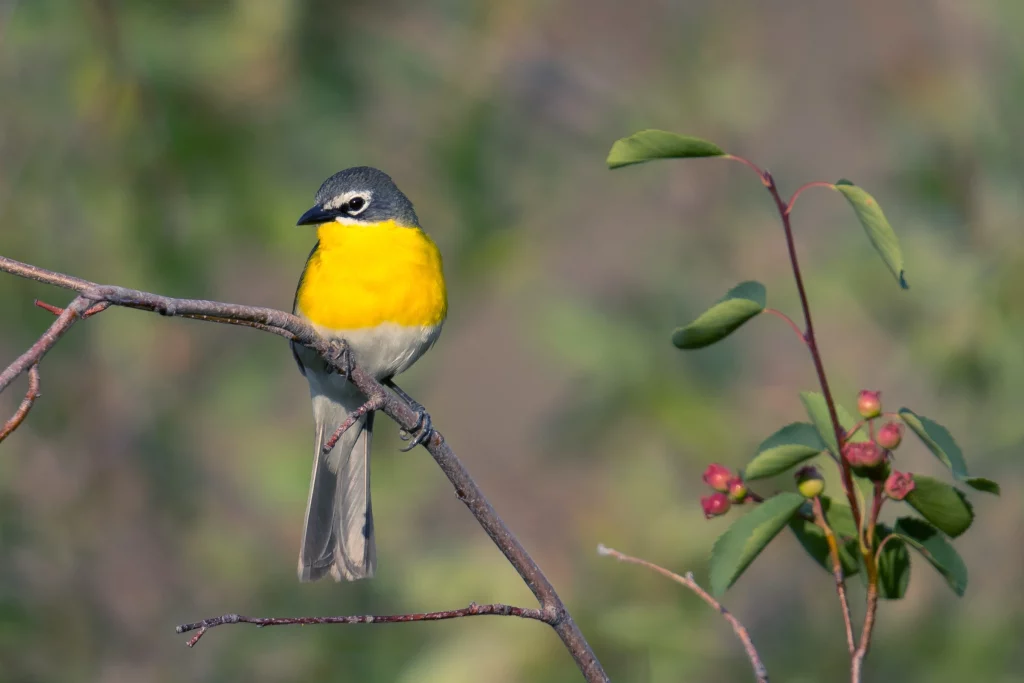
Yellow-breasted Chats breed in Louisiana and are regular residents in suitable habitats. They are known for their unique appearance and distinct vocalizations.
These birds possess a striking and somewhat unusual plumage. They have a yellow underbelly, olive-green upperparts, and a distinctive white eye-ring. Their bill is thick and slightly curved.
Scientific Name: Icteria virens
Length: 7.1-7.9 in (18-20 cm)
Weight: 1.0-1.6 oz (29-45 g)
Wingspan: 8.7-9.8 in (22-25 cm)
Yellow-breasted Chats breed in shrubby habitats, including thickets, brushy areas, and wetlands. They are often found in dense vegetation and can be challenging to spot.
These birds have a complex and varied vocal repertoire, consisting of a series of melodious and harsh notes. Their songs are often described as jumbled and mimic the sounds of other birds.
Listen to the distinct vocalizations of the Yellow-breasted Chat. Tune in to the recording by Richard E. Webster, accessible at www.xeno-canto.org/389652.
36. Swainson’s Warbler
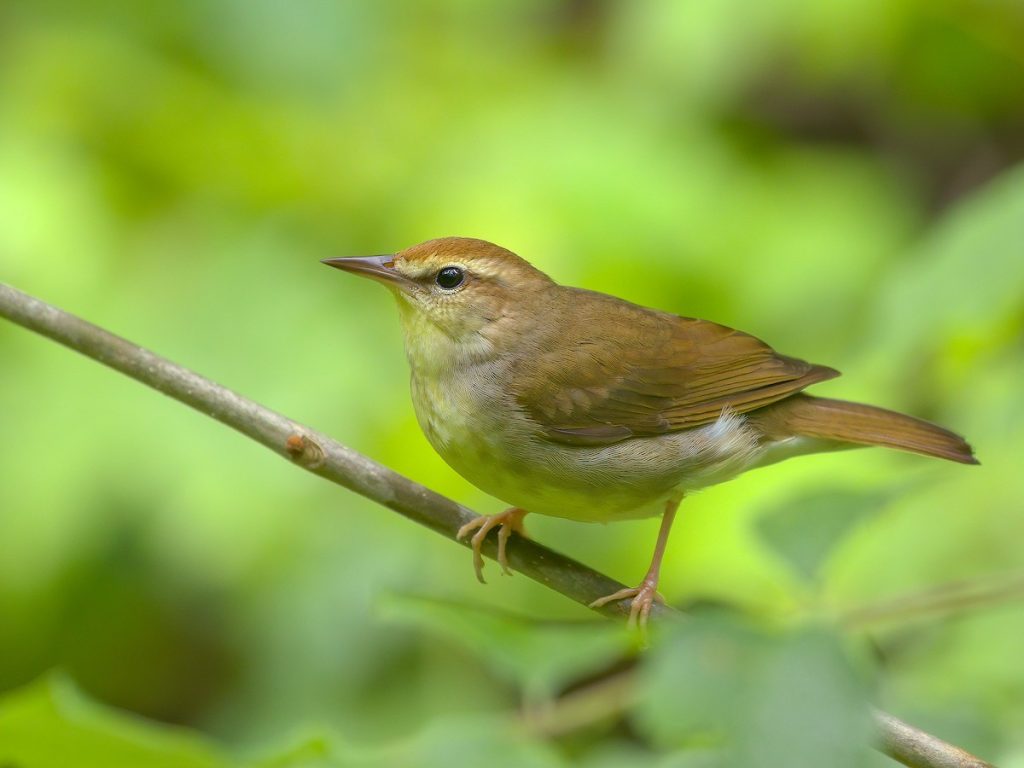
Swainson’s Warblers breed in Louisiana and are regular residents in suitable habitats. They are known for their secretive behavior and unique song.
These warblers have a relatively plain appearance, with brownish upperparts and a pale underbelly. They possess a distinctive white eyebrow stripe and a long bill.
Scientific Name: Limnothlypis swainsonii
Length: 5.1-5.5 in (13-14 cm)
Weight: 0.4-0.6 oz (12-17 g)
Wingspan: 7.9-8.7 in (20-22 cm)
Swainson’s Warblers prefer dense understory habitats, such as bottomland hardwood forests and swampy areas. They often stay hidden in thick vegetation and are challenging to observe.
These birds have a loud and rich song, consisting of a series of musical phrases. Their song is often described as ventriloquial, as it seems to come from different directions.
Listen to the unique song of the Swainson’s Warbler. Tune in to the recording by Andrew Spencer, accessible at www.xeno-canto.org/650365.
Please note that the list provided includes 36 species of warblers that can be found in Louisiana. However, it’s important to keep in mind that bird populations can vary, and sightings may depend on the time of year, habitat conditions, and other factors.
Discovering the Frequency of Warbler Sightings in Louisiana During Summer and Winter
Unveiling the frequency of warbler sightings in Louisiana during summer and winter can be accomplished through the valuable utilization of checklists. These comprehensive compilations offer a window into the warblers commonly observed on ebird checklists in the state.
Summer Warblers in Louisiana:
- The resplendent Common Yellowthroat takes the lead at 14.8%,
- Closely followed by the Prothonotary Warbler at 13.9%,
- The melodious Yellow-breasted Chat claims the third spot with 11.2%,
- The enchanting Northern Parula secures the fourth position with 10.1%,
- While the Pine Warbler gracefully occupies the fifth place at 10.0%,
- The Hooded Warbler adds its charm with 9.6%,
- The Kentucky Warbler makes a modest appearance at 4.5%,
- The vibrant American Redstart enchants with 3.9%,
- The striking Black-and-white Warbler claims 3.2%,
- The elegant Magnolia Warbler also shares the same percentage of 3.2%,
- The Yellow-throated Warbler captures attention at 2.7%,
- Swainson’s Warbler adds its allure at 2.6%,
- Yellow Warbler graces the list with 2.6%,
- The delicate Tennessee Warbler brings in 2.3%,
- The vibrant Prairie Warbler brightens the landscape at 2.1%,
- Bay-breasted Warbler stands out at 1.8%,
- The Chestnut-sided Warbler adds its beauty at 1.6%,
- A striking presence is observed with the Black-throated Green Warbler at 1.3%,
- The Louisiana Waterthrush makes a notable appearance at 1.1%,
- The Blackburnian Warbler shares the same percentage at 1.1%,
- The Northern Waterthrush shines with 1.0%,
- The intriguing Worm-eating Warbler takes the spotlight at 0.9%,
- The graceful Ovenbird also shares the same percentage at 0.9%,
- The Blackpoll Warbler captures attention at 0.4%,
- A rare find, the Canada Warbler, appears with 0.2%,
- Golden-winged Warbler leaves a shimmering impression at 0.2%,
- The charismatic Blue-winged Warbler graces the list at 0.2%,
- Yellow-rumped Warbler displays its unique colors at 0.2%,
- Wilson’s Warbler adds its charm at 0.2%,
- The delightful Nashville Warbler makes a brief appearance at 0.1%,
- The Cerulean Warbler captivates with 0.1%,
- A subtle touch is observed with the Cape May Warbler at 0.1%,
- The Black-throated Blue Warbler makes a gentle statement at 0.1%,
- The Mourning Warbler graces the list with 0.1%,
- A modest presence is noted with the Palm Warbler at less than 0.1%,
- Similarly, the Orange-crowned Warbler is observed at less than 0.1%.
Winter Warblers in Louisiana:
- During the winter months, a different ensemble of warblers graces the landscapes of Louisiana. The enchanting Yellow-rumped Warbler claims the highest percentage at 51.9%,
- The elusive Orange-crowned Warbler follows closely at 26.9%,
- The Pine Warbler adds its radiance at 20.4%,
- The ever-present Common Yellowthroat appears at 8.1%,
- A fleeting visit is made by the Palm Warbler at 5.6%,
- Wilson’s Warbler adds a touch of elegance at 2.1%,
- The Yellow-throated Warbler makes a modest appearance at 0.8%,
- The Black-and-white Warbler brings its contrasting colors at 0.5%,
- A subtle presence is observed with the Prairie Warbler at 0.3%,
- The Northern Waterthrush graces the list with 0.1%,
- American Redstart makes a brief appearance at 0.1%,
- The Northern Parula adds its charm at 0.1%,
- The Ovenbird also shares the same percentage at 0.1%,
- The Black-throated Green Warbler captivates at 0.1%,
- Yellow Warbler makes a delicate statement at 0.1%,
- The delightful Nashville Warbler makes a brief appearance at 0.1%,
- The Yellow-breasted Chat is observed at less than 0.1%,
- The Tennessee Warbler is a rare find at less than 0.1%,
- Similarly, the Cape May Warbler captivates at less than 0.1%,
- The Magnolia Warbler brings a touch of elegance at less than 0.1%,
- The Hooded Warbler graces the list with a modest presence at less than 0.1%,
- The Blackpoll Warbler is observed at less than 0.1%,
- Bay-breasted Warbler brings a hint of color at less than 0.1%,
- The Prothonotary Warbler makes a brief appearance at less than 0.1%,
- A gentle touch is observed with the Black-throated Blue Warbler at less than 0.1%,
- The Worm-eating Warbler adds its allure at less than 0.1%,
- Golden-winged Warbler captivates with a subtle presence at less than 0.1%,
- The Chestnut-sided Warbler makes a delicate statement at less than 0.1%,
- The Blackburnian Warbler adds its charm at less than 0.1%,
- Similarly, the Kentucky Warbler captivates at less than 0.1%.
Methods to Attract Warblers to Your Backyard
While warblers may not frequent backyard feeders as commonly as other songbirds, there are strategies you can employ to entice these melodious avian creatures to grace your yard:
- If your yard allows, provide ample trees to create a welcoming environment,
- Embrace a slightly untidy approach by leaving brush piles, ensuring a friendly habitat for insects,
- Avoid the use of pesticides or herbicides, ensuring a readily available insect population that warblers can feed on,
- Offer a clean water source to quench their thirst,
- Consider providing mealworms, preferably live, or dried alternatives if necessary,
- Set up bird feeders containing sunflower seeds, peanut hearts, and suet to entice these delightful songbirds.
